2023 Safe Non-Toxic Cookware Guide
Written by:
Maia James
11/09/2023
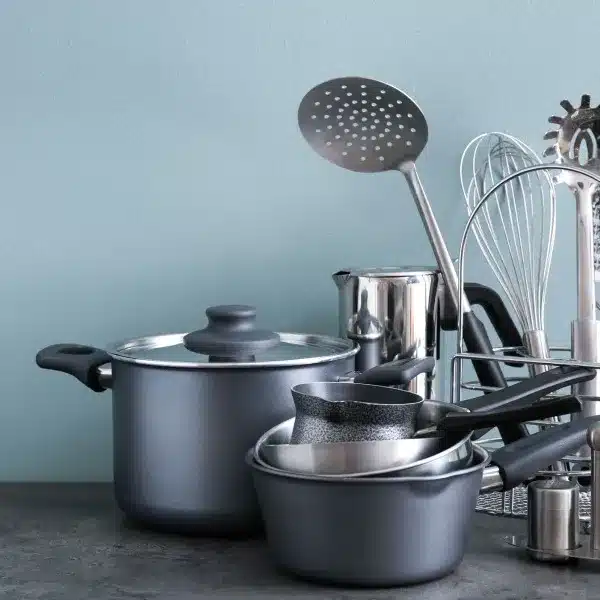
Updated: 04/09/2024
Looking for a different guide? Browse them all HERE.
I’m lucky to live in a neighborhood with lots of great “healthful” restaurants. I put that word in quotes because while organic French fries cooked in trans-fat free oil are better than what you’ll get at McDonald’s, they aren’t exactly kale chips.
So we try to cook at home most nights. My husband is much more of a chef than I am, so he is the one who purchases most of our pots and pans (and woks and stockpots and mandolins and 87 different knives…he loves kitchen gadgets!).
As with many products in our home (from toilet paper to laundry detergent to shampoo), Daylon is primarily worried about the performance of his cookware, and I am mainly worried about the safety. The good news here is that you really can have both. We’ve managed to find high-performing AND non-toxic cookware that both Daylon and I are happy with.
I hope this guide helps you decide what cookware to eliminate, and what non-toxic cookware to buy when it’s time for new pots and pans.
Are There Toxins in Cookware?
Unfortunately, pots and pans might be introducing toxins into your food as you cook. The big takeaway from our research is that most types of cookware do infuse small amounts of material into our food. Some of those things are bad for us, some are good in the right quantity, and some are neutral.
And as much as we should avoid toxins in what we breathe and touch, we REALLY should avoid eating them! For this reason, we consider upgrading to non-toxic cookware an important step for those of you looking to make your homes safer.
My Favorite Non-Toxic Cookware
You’ll find lots of details on a variety of non-toxic cookware options in this guide, as well as materials we’d rather see you avoid. If you’re short on time, here is a cheat sheet of nine brands we love.
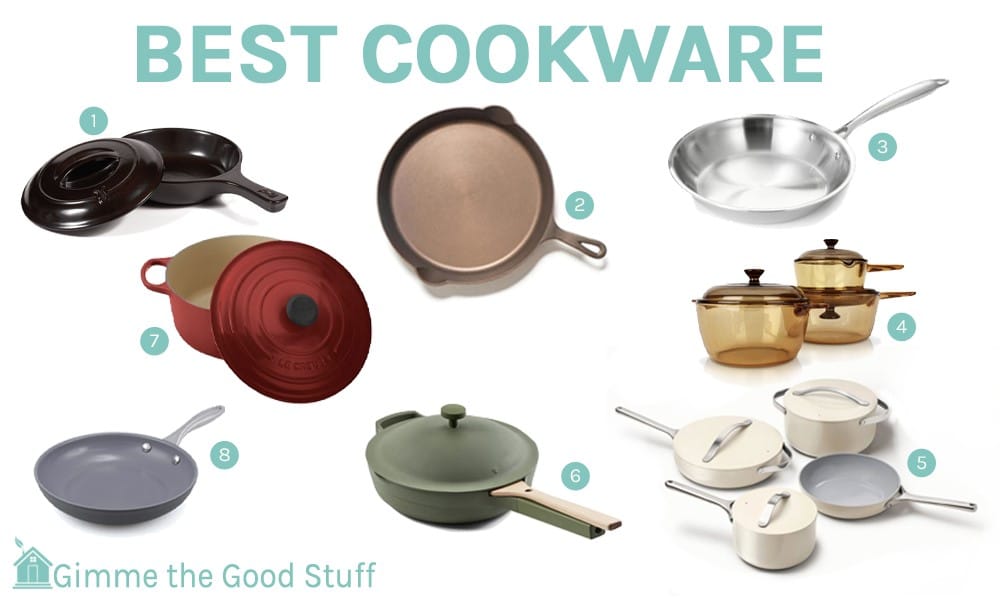
1. Xtrema / 2. Lancaster Cast Iron / 3. 360 Cookware / 4. Visions / 5. Caraway / 6. Our Place/ 7. Le Creuset / 8. GreenPan
Best Less-Stick Cookware
Xtrema‘s non-toxic cookware is the best option if you want NO non-stick treatment. We can’t call it non-stick, but it is “less stick” than the other safest options. You’ll read more about traditional non-stick pans and the newer materials, below.
Types of Toxic & Non-Toxic Cookware
Pots and pans come in a wide range of materials. Some cookware materials are okay, if you have the right variety, or if you don’t use them every day.
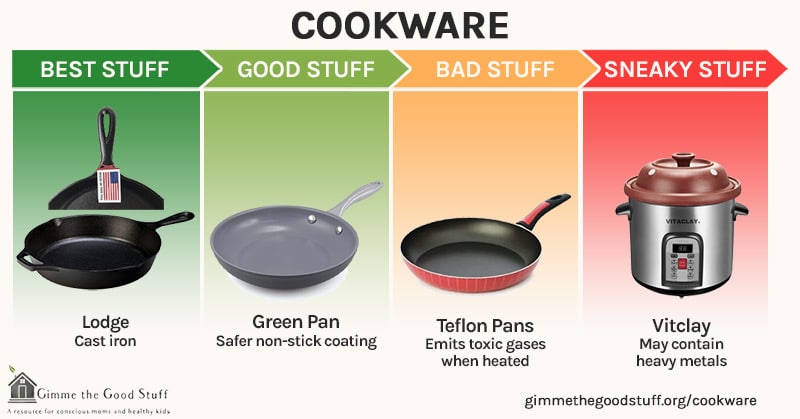
Safest Bets for Non-Toxic Cookware
The following materials are always non-toxic, and we will share our favorite brands below, under The Best Stuff.
Carbon Steel
Carbon steel is sometimes used for frying pans and woks. It’s similar to cast iron, and can leach small amounts of iron into food, which is great if you happen to have someone with slight anemia in your home!
Cast Iron
For most of human history, people suffered from iron deficiencies, so cooking with cast iron helped to prevent anemia. In modern cultures, the opposite is true. Most of us get plenty of iron, and there’s a point at which ingesting too much can be problematic. In our kitchen, we try to switch between cast iron pans and pans made of other materials throughout the week. If you want to be extra cautious, you could avoid cast iron for recipes with long cooking duration or acidic foods, as this will cause increased iron leaching.
Stainless Steel
Stainless steel pans are generally Good Stuff, but stainless steel is made with nickel. The more nickel in the mix, the more “stainless” it is. The problem is that our bodies can handle some nickel, but too much isn’t healthy. This means that high quality stainless steel cookware, which has higher percentages of nickel, is actually of more concern than lower quality stainless steel! We know that stainless steel pans do leach nickel (along with some chromium and iron), especially with longer cooking times and when cooking acidic foods such as tomatoes. To minimize the potential for nickel leaching, you’d ideally want a pan that’s 18/4 or 18/0 stainless steel (that first number is the percentage of chromium; the second is nickel). I wouldn’t be concerned about using stainless steel as long as you just switch up your cookware. If you sometimes using cast iron and enamel pots and pans, you won’t be exposing yourself to too much nickel from stainless steel. If you’re still worried, you could avoid stainless steel when cooking acidic foods for long time periods.
Tempered Glass
Glass is probably the most inert of any cooking surface, and you can even get pots and pans made of this ultimate Good Stuff!
Titanium
Titanium is a non-toxic and biocompatible metal, so it is used for medical instruments, dental implant devices, and joint replacements. Titanium is also lightweight and extremely strong. Titanium cookware uses an aluminum base for even heat transfer and distribution. The non-porous, non-stick titanium outer surface does not allow any aluminum to leach through.The only reason to be cautious about titanium cookware is that it seems that most manufacturers now coat their titanium cookware with non-stick finishes, rendering it “Bad Stuff.”
Materials That May Be Safe (or Not) in Cookware
When shopping for non-toxic cookware, some of these materials come in safe forms. Other times, they are treated (or untreated, as the case may be) in a way that renders them less safe.
Clay
Without testing a clay pot for every possible contaminant, you have no way of knowing what might be leaching into your food—without a glaze on the pot, there is no protective barrier between what’s in the clay and your meal.To me the risks of unglazed clay pots and pans outweigh the potential benefits of the good minerals that might leach into your food—calcium, iron, etc.
Coated Ceramic
Made from natural materials such as clay and minerals, ceramic cookware offers excellent heat retention and distribution. Its non-reactive surface makes it ideal for cooking acidic foods, and it is also appreciated for its nonstick properties, requiring less oil or fat during cooking. Furthermore, it is generally considered safer than nonstick alternatives since it doesn’t contain potentially harmful chemicals like PFOA or PTFE. Ceramic cookware can be considered a safe less-stick if not truly truly non-stick material. Some ceramic cookware is coated with materials that may contain harmful substances like lead, cadmium, and other heavy metals. To ensure safety, it is crucial to choose ceramic cookware that is labeled as free from toxic materials and is certified as being compliant with safety standards.
Enamel
In essence, enamel is a form of glass. Enameled cookware is most often cast iron with an enamel coating. This type of cookware is wonderful to cook with. Some people have worried about lead in the enamel cookware, since the enamel coating is often made of clay, which can leach lead. For this reason, we suggest choosing high quality enamel cookware from well-known brands.
Newer Non-Stick Materials
For more details on these materials, and the brands we like most (and which brands should be avoided), check out the Best, Good, Bad, and Sneaky brands that follow.
Materials to Avoid in Cookware
The following materials are always unsafe when used for cookware. You’ll learn more about how to avoid them under the Bad Stuff and Sneaky Stuff, below.
- Aluminum.
- Copper.
- Nonstick/Teflon
- Plastic
More About Nonstick Cookware
The main concern with nonstick cookware is the chemical perfluorooctanoic acid (PFAS), which has historically been used in the manufacturing process of many nonstick coatings.
There are two big problems with PFAS, also known as “forever chemicals“:
- Health Risks. Studies have linked PFAS exposure to a variety of health problems, including cancer, liver damage, immune system dysfunction, and developmental issues in fetuses and infants.
- Environmental Risks. PFAS can persist in the environment for a long time and can accumulate in plants, animals, and the food chain. This can lead to contamination of drinking water supplies and other environmental problems. (We have a PFAS water filter in our store, by the way.) Worse, PFAS do not break down easily in the environment and are resistant to degradation. This means that even if their use is stopped, they can continue to be present in the environment and potentially cause harm.
If you choose to use traditional nonstick cookware with PFAS, it’s important to follow the manufacturer’s instructions. Avoid using metal utensils or abrasive scrubbers that could scratch the surface of the coating. Overheating the cookware can also cause the coating to break down and release toxic fumes. Of course, our recommendation is that you switch to one of the less toxic types of cookware below.
Best Stuff
Lodge
Reasonably-priced cast iron cookware that’s made in America.
My favorite non-toxic cookware pieces from Lodge:
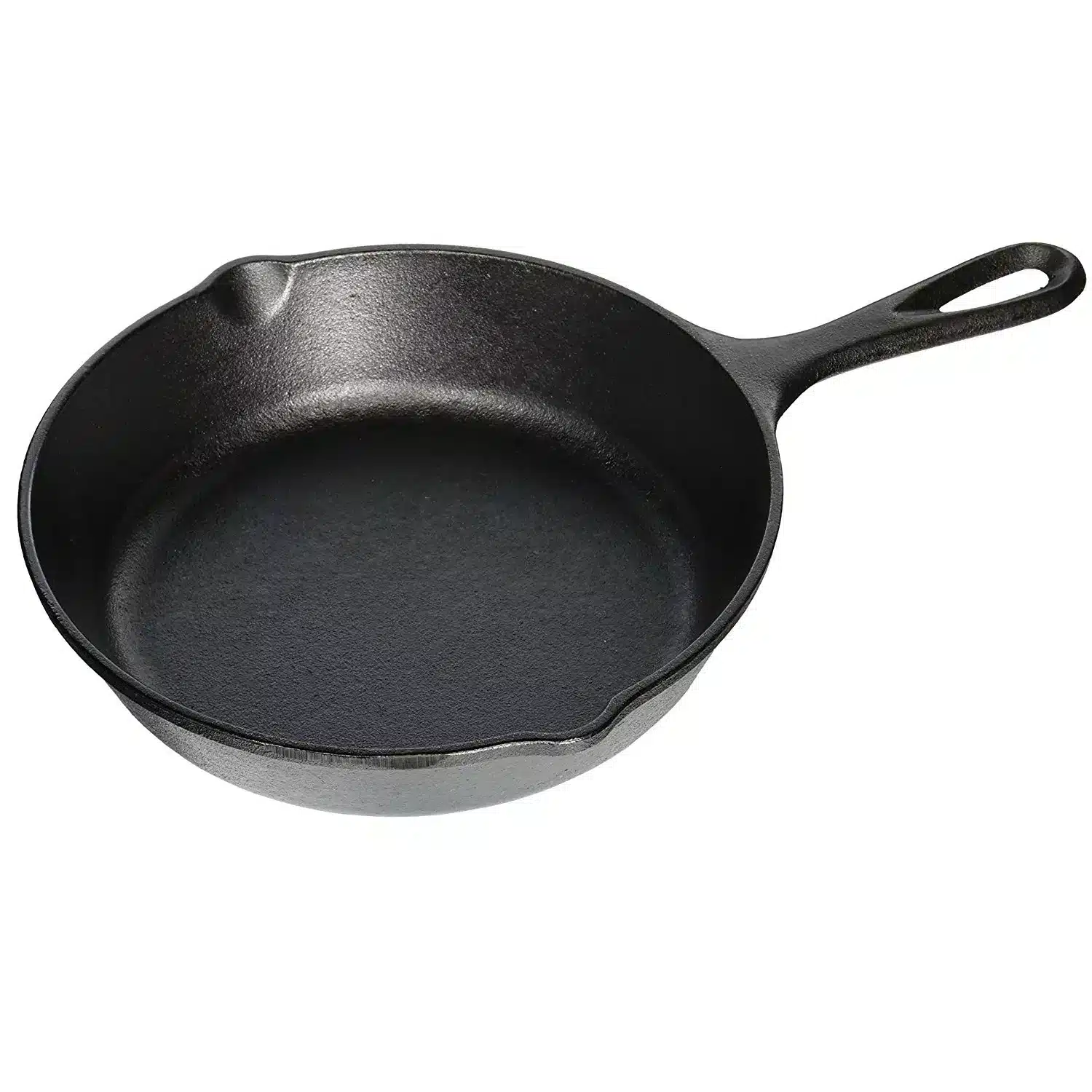
Lancaster Cast Iron
Made in Lancaster, PA, pre-seasoned, and with stout handles and large pour spouts. Each pan is handcrafted and has a beautiful glossy finish that you won’t find in most cast iron skillets.
My favorite non-toxic cookware pieces from Lancaster Cast Iron:
Xtrema
Our favorite brand of ceramic cookware is Xtrema. This line contains no glaze, and each batch is third-party tested for heavy metals. From a performance standpoint, I appreciate that this is much lighter than cast iron cookware.
My favorite non-toxic cookware pieces from Xtrema:
Le Creuset
My friend recently called my from the emergency room after dropping her Le Creuset and breaking her toe. “Is there a more classic Brooklyn injury?” she asked.
In any case, I am sure many of you–wehter you live in Brooklyn or elsewhere–have a hefty piece of Le Creuset cookware in your kitchen. Good news: it’s Best Stuff!
For peace of mind, we got a lead test kit and tested the Le Creuset cookware in two of our homes. No lead was detected. I cannot vouch for other brands of porcelain enamel cookware, but feel good about Le Creuset!
One caveat: Le Creuset says that there are trace amounts of lead on the outside of the bright-colored Le Creuset pots (such as red and orange). They add that “these levels are very low, but the interior enamel is completely free of lead.” I have the orange pot, and the outside still tested negative.
My favorite non-toxic cookware pieces from Le Creuset:
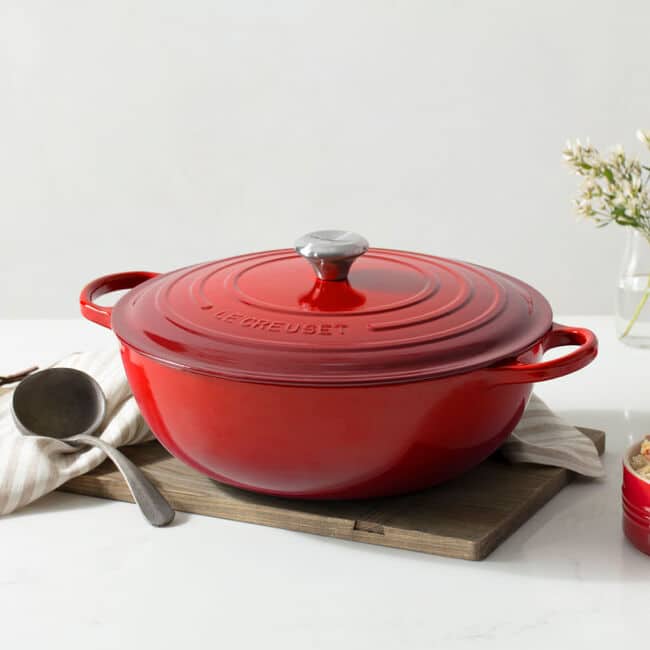
360 Cookware
360 Cookware is our top pick for non-toxic stainless steel cookware. It’s an 18/8 blend, made in the USA, and lasts forEVER.
My favorite non-toxic cookware from 360:
Note: All-Clad also makes toxin-free stainless steel cookware.

Crock Pots/Slow Cookers
Most crockpots/slow cookers contain a ceramic insert. There is a lot of debate about the possibility of lead leaching from the glazing on ceramic pots. In the U.S., all crockpots must pass FDA regulations for lead, but that still leaves the door ajar for small amounts of lead. Many slow cookers are manufactured in China, and there is a general distrust for these products.
We know a mom who went to great lengths to know once and for all if her glazed crock pot might contain lead. First she called several manufacturers and asked about lead in their glazing. Every one told her that there is no lead and their products comply with FDA rules. Not satisfied, she bought a wide variety of crockpots from a local thrift store. These included essentially all of the major manufacturers. She swabbed them with the test kit and found zero lead. She then took the crocks to a testing facility that uses a specific tool that is very sensitive to lead. The results were that there was no lead found in any of the crocks. (I tested my own and had the same result.) So, if you’re a crockpot fan, we say it’s the Good Stuff, across the board.
All-Clad makes a really nice crock pot that is our top pick. You can find others that are less expensive, too.

Carbon Steel Cookware
We like this carbon steel wok and this carbon steel fry pan.
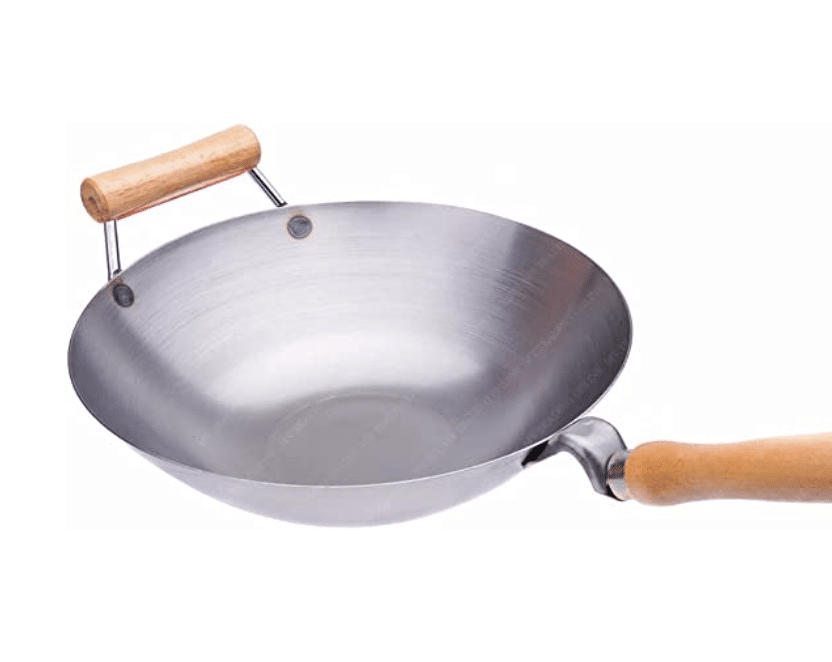
Tempered Glass Cookware
We like this set from Visions.
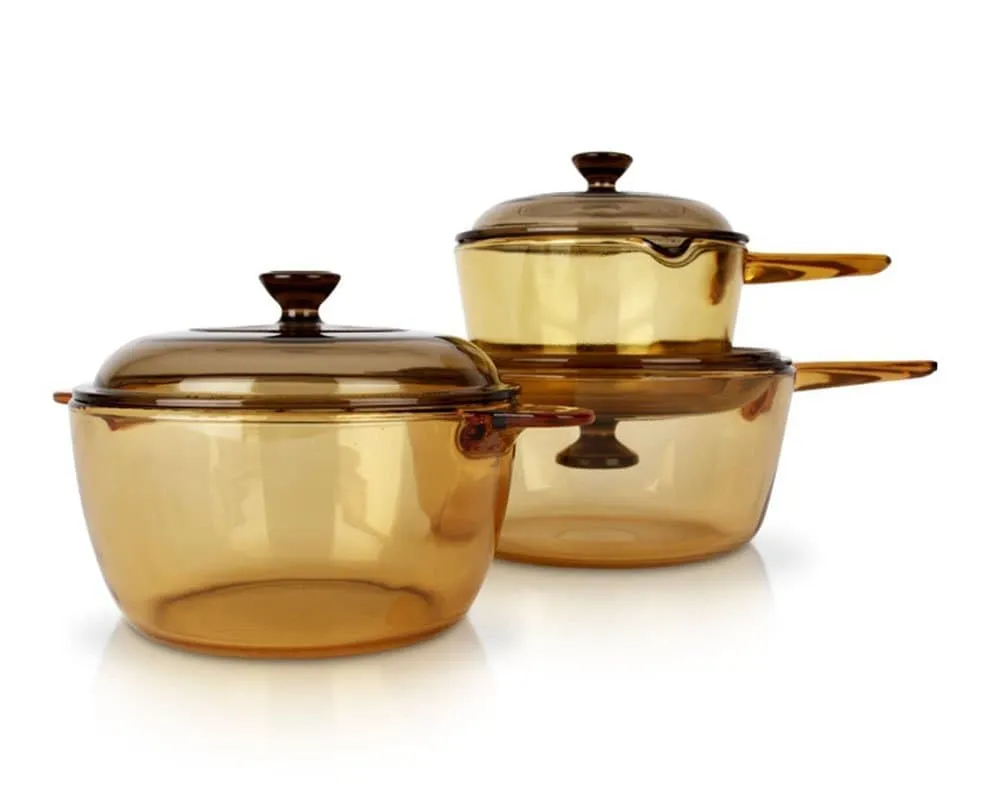
Good Stuff
We are calling the following brands Good Stuff rather than Best Stuff only because they do not disclose exactly what they use to achieve their nonstick coating. The brands below all provide independent testing results that show that their cookware is not leaching toxins or heavy metals. However, it is important to note that this is only true when the cookware is not scratched or degraded. We recommend replacing any non-stick cookware if it becomes damaged.
GreenPan
We originally called GreenPan Sneaky Stuff, because they don’t disclose exactly what they use in their nonstick cookware line. They’ve recently provided the results of independent tests, and these are hugely reassuring regarding contamination with heavy metals.
GreenPan’s nonstick coating is the proprietary Thermion, which is “made by a Sol-Gel process that results in forming a coating layer on the surface of the pan. This layer comprises mainly Silicon Dioxide (SiO2), which is the same composition as glass.” We are now comfortable calling GreenPan Good Stuff!
My favorite non-toxic cookware from GreenPan:
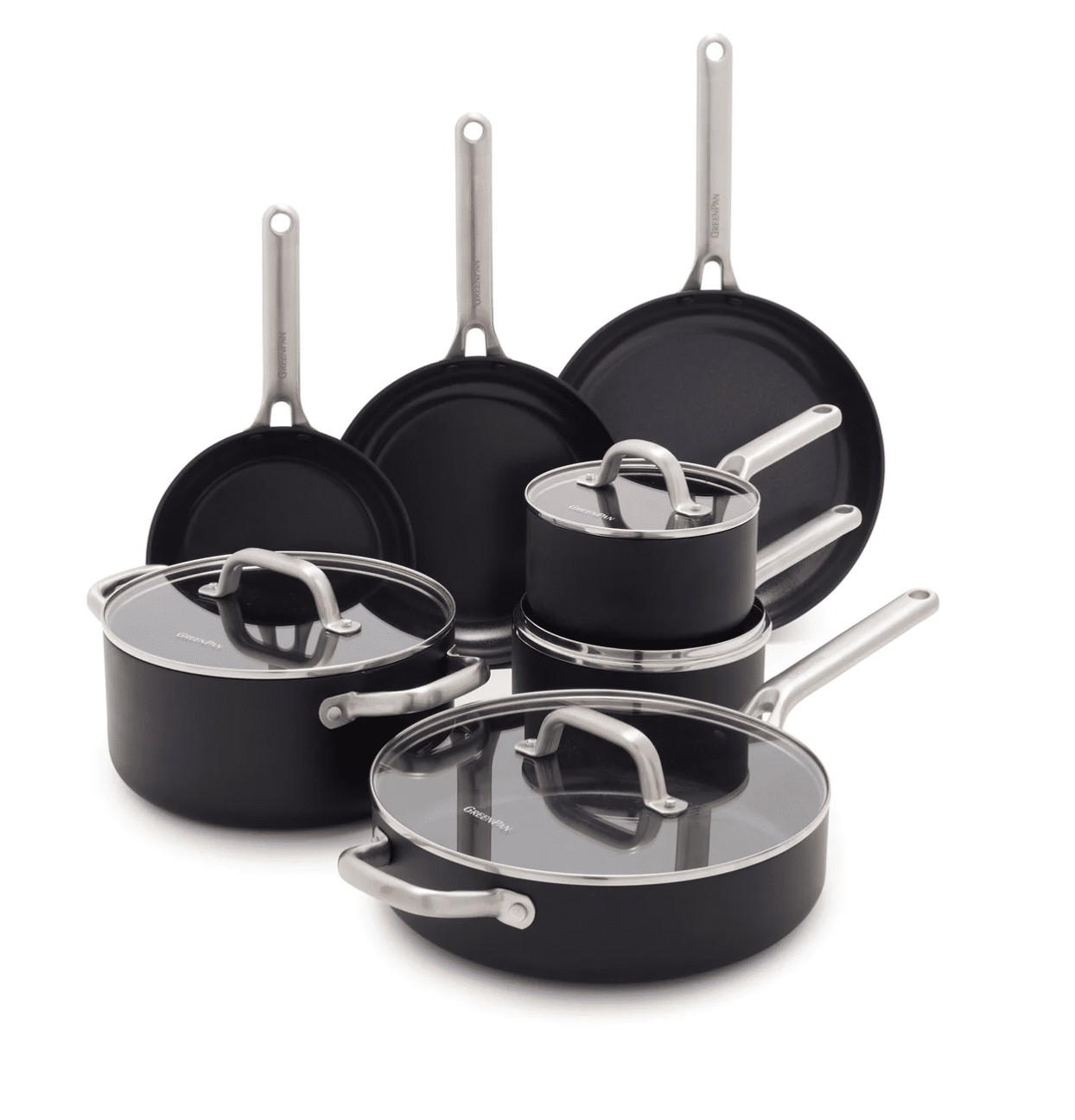
Caraway
Caraway cookware is non-stick and does not contain PFAS. The company has provided reports on lead, cadmium, PFOA, PFOS, and PTFE, which show no detectable levels. One thing to keep in mind is that we do not know the exact composition of Caraway’s non-stick coating as it is patented. While this is not ideal, Caraway has reliable third-party tests that show no detectable levels of harmful contaminants, so we can consider it a good product. Most new non-stick brands use a Sol-Gel process to make their pans non-stick, so it is likely that Caraway does the same.
My favorite non-toxic cookware pieces from Caraway:
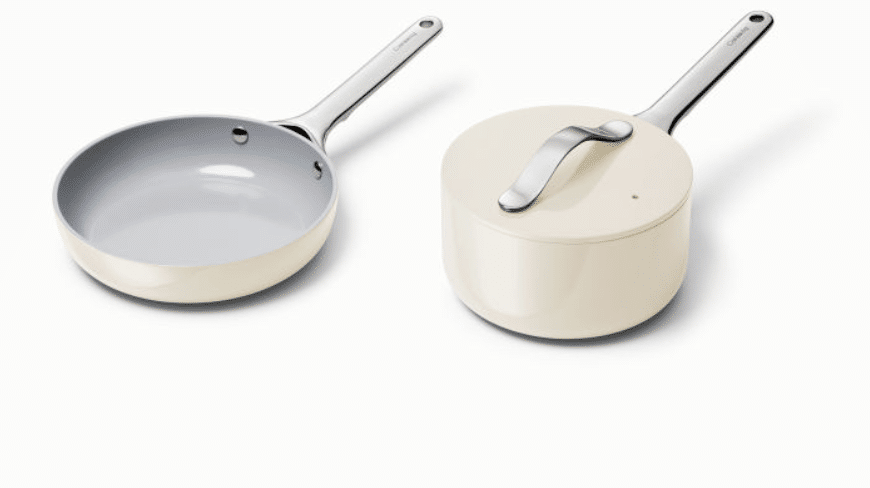
Our Place
Our Place is slightly less transparent than GreenPan, but I still consider this to be a reasonably non-toxic cookware brand. Our Place has disclosed the independent testing that reveals that their pan doesn’t contain heavy metals. It looks to me like they are using the same exact technology (Sol-Gel) as GreenPan. While we’d love them to be more transparent, we can’t call them Bad Stuff or Sneaky Stuff. I have and use various pieces of cookware from Our Place to cook for my family.
My favorite non-toxic cookware pieces from Our Place:
If you’re enjoying this guide, sign up for our Newsletter to be alerted when we publish or update our Safe Product Guides.
Bad Stuff
Plastic
Believe it or not, you can actually get a plastic pot. Don’t buy one; all kinds of Bad Stuff—from phthalates to BPA to worse—leaches out of many types of plastic when heated. (You probably already know that you shouldn’t microwave food in plastic either, right?).
Aluminum
Various studies have linked elevated aluminum levels to everything from anemia and other blood disorders to ALS and Parkinson’s. Avoid all aluminum cookware. Note that pans with an aluminum core within cookware made of safer metals (such as stainless steel) are fine—you just want to make sure that no aluminum touches your food.
Unprotected Copper
Like iron, copper is an essential mineral. A healthy diet supplies plenty of copper, but elevated levels of copper in your body can be toxic.
Many foods can react with unprotected copper cookware (where the food comes in direct contact with the copper) and leach too much copper into your food. Copper-core cookware is fine, though copper cookware that is “protected” with a coating of stainless steel is subject to the same concerns as stainless steel (see above, under The Good Stuff).
Nonstick (Teflon or PTFE)
You can read many reports claiming that Teflon is harmless, but the studies showing it to be toxic are far more convincing. The EPA told companies in 2015 to phase out some of the chemicals in their formulations due to health concerns, and the EWG advises consumers to avoid Teflon.
Most nonstick pans are aluminum coated with polytetrafluoroetheylene (PTFE), otherwise known as Teflon. The big issue with Teflon isn’t ingesting it, but rather breathing it in when it gets hot (it’s actually toxic enough to kill pet birds!). Teflon-coated pans should be avoided.
And yes, even expensive, high-tech non-stick pans (such as Circulon) should be avoided. You can read more about PFAS chemicals in this posts’s introduction, above. A few examples of nonstick brands that have been found to contain PTFE:
- Cuisinart
- Hexclad
- ScanPan
- Zwilling
Sneaky Stuff
“Non-Toxic” Nonstick Cookware
Newer “safe” nonstick pans are increasingly available, but unless we’ve included them above, under The Good Stuff, we advise you to proceed with caution.
Any nonstick pan that says it’s “PFOA-Free” is really Sneaky, because no nonstick pans contain PFOA (it’s created during production but always burned off in the final product). Pans that specify that they are free of PFOA almost certainly contain PTFE.
One especially Sneaky brands is Ozeri, which claims to be PTFE free, but which was found to contain it in samples tested in 2020 by Ecology Center.
Unglazed Clay Cookware (“Earthenware”)
Companies like Earthen Cookware and Vitaclay have gained popularity because they contain no finish of any kind. However, the clay itself can provide a health risk, as it may contain harmful—albeit natural—things like aluminum, cadmium, and lead.
While both Vitaclay and Miriams’s Earthen Cookware do provide testing showing their products free of specific heavy metals, the actual composition of the clay in both cases is “proprietary,” which is why I’m calling both of them Sneaky Stuff.
Coated Ceramic Cookware
Under The Good Stuff, I mentioned ceramic cookware. This is just remember to avoid any ceramic pots and pans that are treated with nonstick materials, which includes brands like Caphalon and Farberware.


Maia, Founder & CEO
Note: This article contains affiliate links or sponsored content, which means that if you make a purchase, we may earn a commission. We only recommend products that meet our strict standards for non-toxicity and that we use (or want to use!) ourselves. Thank you so much for supporting the brands that make Good Stuff!
Enjoying this guide?
Join 60K families who rely on our free guides on everything from milk to mattresses! Sign up to get $5 off your first order, access to our ultimate Clean Products Cheat Sheet, and ongoing exclusive access to coupon codes and promotions. Our weekly newsletter is filled with well researched tips and tricks to live a toxin-free lifestyle.
Related Posts
Start Here: 5 Crucial Steps to Decrease Toxins in Your Home
Questions We’ve Answered Lately…
What Is the Best Non-Toxic Cutting Board?
How To Avoid Drinking Toxic Tea
243 responses to “2023 Safe Non-Toxic Cookware Guide”
-
I left a comment already but forgot to add, where can I find good quality baking pans that are *less expensive*? The good stuff (and even okay stuff) here prices a single loaf pan at over $50 and in some cases a few pieces of bakeware is $300 🙁 I’m struggling to find plain stainless steel that isn’t of dubious quality… thank you!
-
Hello, any good choices for baking sheets? I need to order a springform cake pan, donut baking tray, a pie pan, and loaf pans. I don’t know where to find non-toxic ones! Thank you so much!
-
Great reviewing on choosing the Safe Non-Toxic Cookware. It’s always terrible work. Your post reminds me of the best cookware to keep in your collection.
Thanks. -
Hello. I wanted to follow up on the question about Caraway cookware. Is it good stuff? Thank you so much!
-
euna cookware is also a good purchase to be considered.
FYI, https://eunaknife.com -
I would like to know too
-
I’m curious about the caraway brand too!!
-
Yes, please! I would love to know more about Caraway. They recently released a line of bakeware and I’d like to know if it’s safe…. I haven’t found any good resources for safe bakeware.
-
-
I would like to add my request also for information about Caraway cookware and bakeware.
-
-
I have metal allergies (Nickel) but also react to 14K Gold and some other metals. I’m also highly allergic to mold. Would you say the l
Le Creuset Pan is the best choice for someone like me? (Read That Clay can very easily harbor mold). My issue with the Le Creuset is that I can’t find an SDS or info on what’s in the enamel (Borosilicate Glass: often Includes various minerals including magnesium, silica, or Zinc Oxides) but I have no way to very all materials. I do a lot of searing and Soups. I’m more confident in glass cookware but am worried about what’s best for searing for my circumstances – Thank you! -
Hello everyone!
Any updates on caraway cookware? Have we deemed it safe? Thank you!
-
I keep seeing a new brand, Caraway, being marketed as 100% nontoxic. Any feedback on this brand?
-
Hi! What do you think about silicone cookware? Like stasher bags that you can microware or use to cook sous vide?
-
I have a question about le crueset non stick and its toxicity? Are they recommended? We have a full set. They’re great, but now I’m concerned if they are toxic.
Thanks. -
What non toxic coffee maker do you recommend?
I use a stainless steel French Press but for big family get togethers I need a drip or percolator coffee pot. -
Do you have a recommendation for safe baking sheets? Thank you!!
-
I would love to know this too, please!
-
Yes!!! Baking sheets that don’t warp and are safe!!
-
-
I recommend Trendglas tea kettle. Have had it for several years, works very well. Made in Germany. Made of heat-resistant (I believe science/medical-grade) tempered glass. Found it after some research. Wish they made pots!
-
I have a green pan I thought it’s coated with ceramic, is it?
-
-
I would love to know this too, please!
-
-
Have the Visions glassware pots been tested for lead, etc?
-
Tamara Rubin has a website where she posts lead tests she conducts and has conducted on various products. She says she does not trust Visions glass cookware due to some lead results she registered on their lids.
-
-
Curious about all-clad pans as I try to use as much of this brand as possible. Always think of it as a high standard and made in the USA.
I have an iron disorder so have to avoid cast iron.
-
Lead in pans and ceramic cannot be tested using the lead swabs you recommend. Many of the products you have listed do contain high levels of lead according to Tamera Rubin. She uses a specialized testing instrument Niton XRF.
-
How would you rank Hex clad with its diamond layer to Green Pan?
I was curious if the diamond layer helped the fact that they use PTFE? -
I’m assuming Faberware isn’t any good? I had no idea about how non-stick T-fal or Teflon was until we started looking into getting a pet bird. Then we learned that no only is it toxic to birds but also humans! So, now I’m searching for the best pots and pans (with budget in mind).
-
I saw you put the Always pan on your list for your mom. Can you tell us more about why you like it? I’ve been thinking about the Always pan or Caraway, but don’t know if one is safer and don’t understand the differences between them. Thank you!
-
I am wondering the same thing as Lisa!! Specifically the research on the Always Pan and why it is safe.
-
-
what about Stone Earth Frying Pan by Ozeri?
https://smile.amazon.com/gp/product/B00GG5FBKW/ref=ox_sc_saved_title_6?smid=ATVPDKIKX0DER&psc=1
THANKS!
-
Thanks so much for this information! Do you have any specific suggestions for cast iron maintenance? I’ve heard coating with flaxseed or grapeseed oil is a good idea after cleaning but I’ve also heard that grapeseed oil is not something we should be consuming. Any thoughts? Thanks so much in advance!
-
Hi Alison, 1. CLEAN CAST-IRON SKILLET AFTER EVERY USE
Wipe interior surface of still-warm skillet with paper towels to remove any excess food and oil. Rinse under hot running water, scrubbing with nonmetal brush or nonabrasive scrub pad to remove any traces of food. (Use small amount of soap if you like; rinse well.) Need to remove stubborn stuck-on food and grime? See our more intensive cleaning tips for tackling them.2. LIGHTLY OIL AFTER EACH CLEANING
Dry skillet thoroughly (do not drip-dry), then heat over medium-low heat until all traces of moisture have evaporated. Add 1/2 teaspoon oil to pan and use paper towels to lightly coat interior surface with oil. Continue to wipe surface with oiled paper towels until it looks dark and smooth and no oil residue remains. Let pan cool completely
-
-
Hi, thanks so much for this article. Do you know anything about the Caraway cookware and if it’s safe?
-
Hi Maria,
As someone else also inquired, I’m curious about the Caraway cookware!
Thanks!
-
Hi Maria, Thanks for the questions. The most asked question regarding ceramic pans is if they’re safe to use.
The popularity of ceramic cookware actually first accelerated when the toxicity of PFOA-rich Teflon (used on nonstick cookware in the past) made headlines. Nowadays, you’ll often hear from marketers, “Safe under high heat and even when damaged, the ceramic coating applied to ceramic non stick pans provides a simple, non-toxic solution to chemical coatings.”
This claim, however, is unproven. Sol-gel cookware is deemed safer mainly because it has been studied less. Sol-gel ceramic surfaces are “self-sacrificing” surfaces, which means their coating is released during cooking and ingested along with the food. There is not yet enough evidence or studies to determine conclusively whether or not ingesting small amounts of silicone oil is harmful to the human body.
-
Was your response an answer in regards to the Caraway cook/bakeware? Also, your statement,
“Sol-gel cookware is deemed safer mainly because it has been studied less.” What?
I find your response to whether or not you deem Caraway cook/bakeware safe confusing. Could you clarify?
-
-
-
-
Any comments or info on the Nuwave Air fryer?
-
Pretty sure that you did the lead testing wrong on the enameled cast iron.
Going from your pictures the way you tested won’t ever result in a lead indication.Cheers
-
Have you looked at hexclad. They are expensive but if they are safe then seem like a good option.
-
I would like to know about Hexclad as well!
-
-
I am on a tight budget. I bought a 3.4 qt. stainless steel enamel coated stovetop casserole. It’s by Atelier Chefs, and made in Serbia. The only visible metal is in the thin rim. There is a pale yellow exterior, and a light cream colored ceramic on the inside, which has tiny specks of what looks like metal all through it. The ceramic surfaces are all smooth, inside and out.
So far I have sauteed onions, eggs and simmered some vegetables. I would like to brown some chicken, and simmer it with vegetables and a sauce til done. Any advice?
-
Hi Maria- have you researched the scan pan? Would love your opinion. I would also like suggestions for cooking sheets and muffin pans. Thank you. I reviewed all the questions above and don’t see your responses to any of them. Do you post your responses anywhere or do you not respond to questions. Thanks!
-
Have you had a chance to look into a company called made in USA. I think they are all stainless steel. It seems like mostly professionals are using it but really curious how safe it is.
-
I just came upon this product. Caraway cookware.
https://www.carawayhome.com/pages/faq#reamaze#0#/kb/product/how-safe-is-your-non-stick-coating
Sounds fishy to me. They don’t tell us exactly what the “Non stick” is. Thank you and happy belated birthday!
-
Hi Maia,
Wondering if you’ve heard of Aluminized Steel for bakeware and where that might rank on the list of baking materials? -
does anybody know anything about ASTA cookware from Germany?
I believe it’s enamel on cast iron and they are decorative -
Hi Maia! Thanks for all of this great info on cookware. I bought the Cuisinox wok and Xtrema mini sauce pan per your recommendation and now I am upgrading my frying pans and larger sauce pans. Have you researched Caraway brand yet?
-
Le Creuset has some bakeware made of carbon steel, are they safe? Would you call them good stuff?
-
Do you consider Misen good stuff? They say their non-toxic coating is a “3-layer DuPont platinum.” Thanks for the help!
https://www.misen.co/products/nonstick-pan?variant=30975851626577
-
The carbon steel wok seems to be unavailable everywhere – is there anything you’d recommend instead?
-
Hello,
I am in search of non-toxic bakeware (cookie sheets & cupcake pans). I went into Le Creuset’s website and they have supposed non toxic bakeware available. It is made of heavy gauge carbon steel, but also stated to have “PFOA-free nonstick coating”. I’m curious as to your thoughts . Thank you.
https://www.lecreuset.com/muffin-pan -
Hi! Have you heard of Our Place cookware? I would love to know your opinion on those. Thanks!
-
Yes, I’m curious too!
-
-
Would love to hear thoughts on this cookware!
-
The 3 most popular types of cookware, which are most often seen on the shelves are ceramic, nonstick and stainless cookware. When cooking, you will need to consider a number of features that accompany each material. Depending on your needs, you should make the right choice. What is better to buy?
Some tips: https://cookingtopgear.com/ceramic-vs-nonstick-vs-stainless-cookware/
-
I wonder the same MEG. Maia, do you know if USA Pan cookware and bakeware is safe?
-
I really need some rectangular baking dishes for the oven (casseroles, reheating etc.) and none of the safe brands mentioned make any that are somewhat non-stick except Wilton “Texturra” Carbon Steel. Is Wilton a safe brand? Its hard to know if they are non-toxic solely based on the material, as you had mentioned some are not made with the right They seem to be mostly pots and pans, as opposed to baking dishes. Any tips for some safe 9 x 13 baking pans/dish? Thanks!
-
I found some carbon steel bakeware from Le creuset. Are they safe and good stuff?
-
Hi, I love your website! Just curious if you have any recommendations for non aluminum muffin tins and cookie sheets. Most I seem to find are all some type of aluminum! Also would using unbleached parchment paper on the aluminum baking sheets decrease the amount of aluminum leached onto the food? Thank you!!
-
Hi Christina, You can find stainless steel muffin tins and cookie sheets which is what I would recommend. Certainly using the unbleached parchment paper would help.
-
Hello Suzanne,
What brand of stainless steel muffin tins & cookie trays have you found? I have been looking for a while but nothing has popped up.
Thanks!-
Oh goodness, I have no idea I have had them forever. I did a quick look on Amazon and found these. https://amzn.to/3nRaXoh for muffins. And these cookie sheets. Just avoid aluminum or non-stick ones.
-
I have no idea I have had them forever. I did a quick look on Amazon and found these: https://amzn.to/3nSpkZi
And this: https://amzn.to/3emzLBe
-
-
-
-
Have you ever looked into USA Pan cookware and bakeware? They say that the bakeware is aluminized steel and “The coating applied on most USA PAN® bakeware is Americoat™, our proprietary silicone release coating which is used on almost every commercial pan in North America. It is a natural non-stick and non-toxic silicone that is PTFE, PFOA and BPA free. Americoat™ is clear in appearance and lets baked goods release quickly and effortlessly.” This sounds non-toxic, but wondering if they’d give you more answers or if they have an testing. I appreciate that they have the purple food allergy line and am wondering if whatever is in it that makes it purple is toxic?
The cookware appears to be similar to All-Clad with an aluminum core and stainless steel exterior so I believe this would be safe.
-
I’m trying to find a donut pan that is non-toxic and I can’t seem to find one. Do you know of any non-toxic donut pans?
-
Hi I would love to k ow your thoughts on the Cinder grill.
On the website it says that it is made of anodized ceramic enamel. I’m not sure if that falls under ceramic and how can we know if they use a non stick coating?
Thank you! -
Purchased a set of Xtrema cookware and was extremely unhappy. The pans do not cook evenly, the are very heavy and the handles are HOT. I purchased the silicone covers for the handles, but they were hot as well. When I discussed this with Bob at the company, I was told that the you shouldn’t put the handles on for cooking. I don’t know how they expect you to put the handles on once the pans are hot, especially as they are so heavy. The product also chips VERY easily. They may be the “good stuff” but I would highly discourage you from buying them.
-
Echoing Feroza’s question:
What bakeware would you recommend? I’m hoping to start making healthy snacks for my toddler son, and easiest would probably be healthy muffins we can take with us. But I couldn’t figure out what bakeware would be considered safe based on your blog above. What do you use? I would be so grateful if you have any to recommend!
Thanks,
Mason -
What is the safest bakeware to use? I’m guessing aluminum muffin pans are not good. Is it ok to use aluminum with a unbleached paper liner? What about those silicone muffin pans? Are they safe to use? Thanks for all your help! 🙂
-
is Greenspan safe? Even if it non stick coated, it claims to be safe…
https://www.amazon.com/gp/product/B074CVZ7MM/ref=ppx_yo_dt_b_search_asin_title?ie=UTF8&psc=1 -
Is Blue Diamond cookware (skillets) safe & non-toxic as the company claims?
Thank you! -
I read that Extrema,Rachel Ray and Ayesha Curry is made in China ,and that we should avoid all products from China.I recently contacted Lloyd Pans and I was told they do use and or produce their items in China .I keep hearing green pan and green life are safe to use but are made in china and green pan is sneaky. Which brands of cookware and utensils are safe and made in the U.S.A. ?This drives me crazy because now I feel I have to throw everything away.
-
Does anyone have a recommendation for safe stainless steel flatware? We need new knives, spoons etc 🙂
-
Hi I have a quick question.
What is your opinion on Landhaus cook wear
I bought the Dutch oven from Amazon thinking it was made in Illinois but opened it and noticed it was made in China. Really bummed me out.
I also can’t find anywhere on their sight saying if it free from lead and other toxic chemicals.
Any insight? -
I have many, many pieces of rarely used Calphalon Commercial (NSF) Anodized Aluminum cookware from the mid 1980’s.
Can the be safely used if I see no aluminum showing (like from scratches)? Thanks. -
Salad master. Anyone use this brand of cookware? I am so interested but it is extremely pricey. And don’t want to waste the money on something not worth it.
-
Has anyone used/tested TeamFar products? They claim to be pure 18/0 stainless steel. I’ve only found their products from a handful of online retailers. Their prices are very affordable which has me wondering if it’s too good to be true.
Thanks!-
I was wondering about this company as well. Hope they have some input.
-
-
Hello ?
I have very old enamel cookware that has been passed down. It is
Prizer-Ware, made in USA.
OS and 858 are also impressed on the bottom. The enamel (an aqua color) has worn thin in spots, there are scratches and some small, dark pitting, but a relatively smooth surface.
It’s a favorite, but stopped using it awhile ago, because I am uncertain about it’s safety.Is there a place that could safely re-surface the enamel?
Thank you,
Sue -
Xtrema cookware tested positive for lead and cadmium, here’s the link: https://tamararubin.com/2018/08/july-2018-ceramcor-xtrema-saucepan-update/?fbclid=IwAR0jGv9VOG0Pp3eIc0fGT0yt6XcF4vhuo_pPQWwToRdb2PZh-BU67lMmUbg
-
What about the safety of the Swiss Diamond brand (made in Switzerland) pans? Description states: “Patented nonstick coating reinforced with real diamond crystals (PFOA-free)”
What is a good alternative to non-stick cookware for when you don’t want the food to stick too much? -
I see (and agree) with your recommendation for Le Creuset porcelain enameled cookware. But what about Le Creuset “enameled cast iron” skillets ? Is this equivalent to a standard “cast iron” cookware (such as a Lodge cast-iron skillet), in that we should limit how much we use it in order to not take up too much iron? Or does the enameling process make it safer and more like the Le Creuset porcelain enameled cookware, which we can use every day?
Thank you
-
We are cast iron cookware manufacturer in China. We make with DISA production lines. We have been in this business for more than ten years. Our production capacity is 200,000 pcs/month. We offer quality products with competitive price.
Try cooperating with us. We are sure to be a surprise for you!
Our website is at http://www.jsycookware.com . Please browse through for more detailed information.
Email: christine@jsycookware.com -
What are your thoughts on Lodge’s porcelain enameled cast iron dutch oven? Here: https://shop.lodgemfg.com/dutch-ovens-and-casseroles/6-qt-dutch-ovens.asp Any risks of lead? On their website, they state: “After the iron cookware is cast in the traditional method, a glass particulate called “frit” is applied.” Thank you for your help!
-
What about Cuisinart Enameled Cookware and Cast Iron?
-
I’m new to this, and am trying to (slowly) rid my home of toxins. Do you have any recommendations for dinnerware?
-
Hello
I bought some xtrema cookware after reading your cookware guide. I also bought silicone steamer that they have.
Now, I wonder if silicone steamer is safe… What do you think? -
Saladmaster Cooking Systems are the best to use.
Maximised nutritional value and purity during cooking time is guaranteed as temperature is maintained well under 90 degrees celsius and they are made out of 316Ti ( 316 Titanium stainless steel ) which is inert , non-leaching . Unique cookware with lifetime warranty . The best . -
What do you think of Pyrex and Corningware, including vintage items?
-
Are the skillets by Le Creuset safe? (Not Dutch oven)
Thank you! -
Highly informative article. This site has lots of information and it is useful for us. Thanks for sharing your viewsCookware Oven Hot Pad and Pot Handle Holder
-
I’m searching for healthier cookware. I am wondering your thoughts on the Goodful, which is made specifically for Macy’s? It’s ceramic cookware is a new line for Goodful. Wanted to know if it past your test for healthy “good” cookware?
-
The best is Saladmaster.
-
-
Thank you so much for this article! What can you tell me about Bialetti Aeternum ceramic, non-stick cookware? I read your section about the “sneaky” brands that say PFOA-free, and I was concerned when I read that on their label, but then it also says PTFE-free. In your expert opinion, is it still “sneaky”?
Thank you!
-
I’d like to know more about this lavarock. I clicked the link and Amazon is not sure if it will be back again. Any other recommended brands or just this one (which is discontinued). Also any other carbon fiber brands you recommend?
Thanks in advance
-
Thanks for your information dear. I get to know some useful ideas about the product guide.
-
What about Carbon Steel?
-
Wow nevermind I just saw that that is first on your list! Sorry for being so unobservant! I love this page – I refer back to it every time I am shopping for cookware!
-
-
I’m looking into different brands for Stainless steel pans (All-Clad, Calphalon, etc) and it is really hard to find pans that are actually 100% stainless steel. They all have some kind of clad technology where the aluminum core is clad with stainless steel. Are these still fine? The ones that are 100% stainless steel have a heavy bottom that is made of aluminum and wrapped in stainless steel. What are your thoughts on these?
-
Could you tell me if the “Instant Pots” are safe? I know you mention slow cookers, but since these are so new, I was’t sure if that was included.
-
What are your thoughts on boiling water for coffee and tea in a stainless steel kettle? I do this every day several times a day. Am I getting trace amounts of metal in every cup? I noticed you recommend kettles from xtrema and staub, but those are kind of pricey and heavy so I was just wondering if my cheap stainless steel kettle is ok. Since there is no scrapping of the kettle but just boiling of water, I wonder if any leaching is occuring. Thanks
-
Hi guys
Just wondering is it ok to store food in the stainless steel pot that it’s been cooked in? I usually do that. I wonder if it’s a bad thing. Thank you so much-
Yes, it’s fine for short term.
-
-
Hello – I saw a few others mention that Greenpan’s coating is silicoN and not silicoNE – I was wondering if this changes your recommendation? I would love to buy the xtrema, but I have heard terrible things about how easy it is to break ceramic cookware – and unfortunately cookware is something I can’t afford to replace! My current set is terrible and I really need to settle on something healthy and durable.
-
I appreciate it when you said that it wouldn’t be dangerous to use stainless steel as long as the person changes the type that they are using every once in a while. If so, then it’s good since mom has a ceramic cookware available in the house. She just needs stainless steel for some dishes that seems better made if the cookware is made out of the material. I will mention this to her. Thanks.
-
Can you share thoughts on this?
Thanks,
Karen -
I have a lot of Corning Ware casserole dish’s but have read some of them have lead in the design on the outside? Also some can have arsenic in them? The designs I have are Spice of Life and Country Festival. I also have a lot of Stainless Steel Revere Ware with copper on the outside bottom of the pans. Are there any health risk cooking with the above cookware?
Thank you -
does anyone know if “red copper” cookware is toxic?
-
What about “ceramic copper infused cookware” otherwise known as “Red Copper”? Thanks
-
Hi! I’m looking for cookware that’s on the “safer” side, preferably non-stick (that i’m finding is not particularly safe even if it’s “safe”). At this point, the research has got me completely bonkers. The metals, the toxins, the tests, the results, warnings, recommendations to this use this pan for that, that pan for this… It’s overwhelming. I’m no expert cook, I don’t think about possibly using using cast iron for one dish and stainless steel for another. I just want a decent home-cooked meal without thinking I’m poisoning myself because of the cookware I’m using or double poisoning myself because I burned “whatever “the other day in the cookware i’m using. I’ve spent three and a half decades of my life eating what was put before me without a thought of what it was cooked in, and seem to be just fine, so I’m not sure why it matters, but it does! For whatever reason it does. I don’t own a microwave or use aluminum foil if I don’t have to and I don’t even remember why, haha… Ugh, I’m cookware babbling. In a nutshell, I’ve narrowed it down to two brands/three types. Le Creuset: toughened non-stick, and two GreenPan: Padova ceramic non-stick OR Paris Pro anodized aluminum ceramic. I did read about GreenPan and the use of silicone, but other articles have said it’s silicon, sans the e, and that there’s a difference. More to overwhelm me, sigh. But I must forge on! There’s mediocre pastas and soups and breakfast dishes to be made! Any words of wisdom/advice on the three I’ve listed? And knowledge regarding silicone vs. silicon?
Thanks for taking the time to read this. -
Do you know anything about circulon anodized cookware? It’s label non stick. Just want to make sure it’s bad before I ditch them.
-
Hi Joanna, We remain wary of any aluminum cookware. We don’t want to be alarmist. Having said that, almost every “non-stick” cooking surface that was once deemed “safe” has later been found to be concerning…at best.
-
-
Hi, how can you determine if a ceramic coated or porcelain enamel pan is treated with a non stick chemical? I’ve seen many advertised at “Ceramic coating is naturally non stick”…which sounds like it hasn’t been treated with an added chemical but of course that can be misleading. Can you give any advice on how to determine this? Thanks!
-
Hello,
I’m wondering if you ever heard of the brand The Rock by Heritage and what your thoughts are on that type of cookware.
-
Thanks for sharing this guide. It’s very informative.
I was wondering, which cookware type would you recommend for a beginner to start with? -
Hi Maia,
I’m looking to get a deal on safe cookware and found a couple at Costco. I’m wondering if they’re actually as good as they advertise. Do you have any knowledge on these brands?
Green Pan- ceramic nonstick, and stainless steel on the the outside
Henckels- ceraforce ceramic nonstick, PTFE and PFOA free, and stainless steel tri-ply clad
Thank you!
-
Hi Audrey,
John here…
We are not fans of any cookware that claims “non-stick”. There are several new-ish technologies out there but we are yet to be convinced that they are totally non-toxic.
-
-
Hi Maia and John – Do you have thoughts on non-toxic cutting boards or plans to develop a guide? I’m having trouble finding anything that I feel confident isn’t filled with glue or, if it isn’t, would be safe for cutting meat. Thoughts? Thanks!
-
Hi Maia,
I really value your site and use it frequently as a tool for purchasing the healthiest items for my family. I recently went ahead a purchased a few pans from Xtrema and have generally really loved cooking with them, however, I recently came across an article by Tamara Rubin http://tamararubin.com/category/xtrema/ about her finding lead in their branding on the bottom of the cookware. What are you thoughts on this? I really do love the brand and I hope it is safe to cook with.
Thank you.
-
Hi Alyssa,
John here from GGS…
Thanks for the great question. I read the blog by Tamara Rubin and followed the back and forth email thread between
Tamara and Richard Bergstrom (Head of Ceramacor/Xtrema) until my eyes were falling out! 🙂
This is a classic example of just how difficult it can be to arrive at “THE TRUTH” when researching these sorts of things.
Here at Gimme the Good Stuff we try to arrive at conclusions, and make subsequent recommendations based upon reasonable,
real-world concerns. We’ve found that once we skew towards extremes it is a slippery slope into vast amounts of both data
and opinion. Once that starts most of our readers can simply sigh and give up. Our site exists to provide folks with
short-cuts to a realistic view that will allow them quickly make decisions about which products to buy/use while retaining
a sense that they are taking reasonable steps to reduce the toxic load that we are all exposed to.As for the Ceramacor/Xtrema debate… It is true that lead is ubiquitous in the modern world.
It is also true that we should avoid it whenever we can.The tests conducted by Ceramacor are done to discover if any heavy metals could leach from their products over time.
This is the extractability test. The test used by Tamara is the XFR test which bombards an object with gamma rays and
“reads” the atomic-level reactions for signatures of various compounds/elements.
XFR tells us if there are ANY heavy metals in an object.
Extractability tells us if any heavy metals are likely to escape from an object and thus present a threat.I believe that Mr Bergstrom is correct when he suggests that there is essentially zero cookware on the planet
that is 100% free from any heavy metals or toxins. He is also probably correct that Xtrema cookware is likely
the most rigorously tested cookware available. This does not mean that Xtrema is 100% free from lead and the heavy metals.
It simply means that exposure to those substances is unlikely.In this particular case they discuss the label baked into the enamel on the bottom of the pan, It seems clear that lead paint
may be used on that label. It is also possible that after extensive use/wear the lead in that label might become exposed. That is indeed a concern.The enamel coating applied to these pans is fired at around 2500 degrees…far far hotter than your pan will ever get sitting on top of a burner.
This means that it is unlikely to simply melt and expose the offending label. But as we all know, the bottom of pans can become abraded over time
and in that way the lead might become exposed.There is no reasonable way for us to determine how many months, years or decades it might take for that to happen.
So it comes down to this: Xtrema is likely the most tested cookware on the planet and it appears to pass all the governmental
standards. (many governmental standards are not as rigorous as some of us wish but that’s another conversation)Without similar tests conducted on cast iron, stainless steel, carbon steel, glass etc it is not a truly level playing field.
People have been cooking with cast iron and stainless steel for a long time so we tend to think they are ok…and generally speaking
they probably are ok. Generally speaking Xtrema is likely also ok.If I were in the market for Xtrema I’d probably wait to buy until Mr. Bergstrom changed the labels.
Thanks,
John Goss
-
-
Is the Pioneer Woman porcelain enamel nonstick aluminum cookware safe or sneaky stuff? Thank you!
-
Hello, thank you for the information. Is the Pampered Chef Stoneware line healthy? It seems like a good option that becomes nonstick over time with use. Thanks!
-
Hi Maia—
I also had that question about the Ziploc freezer bags. Can you share with us why you are okay with them? I would love to use but have a baby and want her to be safe, etc.
Also: As long as I’m typing—one of your readers mentioned concerns with stainless steel from China on your FB page. Ever heard that?
-
SaladMaster makes uncoated titanium pans. They are unconscionably expensive but I love the one I have (bought used on eBay, i would never pay full price).
-
Hi! For teapots do you recommend switching from aluminum to stainless steel? Thanks
-
Yes, I do!
-
-
Thanks for sharing this Content.What area unit your thoughts on the Green pan Diamond, specifically Diamond pots and pans?
-
Hi! Just wondering if you had seen the results of this test done on xtrema and if so whether you thought it was concerning? About to take the plunge and completely revamp our cookware and would love your thoughts on this before purchasing any xtrema products 🙂
-
I too read this the other evening. We switched over our cookware to Xtrema over the last year and a half and now I’m concerned with our choice! I’m wondering your thoughts on this testing as well Gimme the Good Stuff.
-
Hi there-
This is on Marcela’s label–which the Xtrema pan doesn’t have. But regardless, the label isn’t going to leach into food and isn’t of concern.
-
-
Currently we use All-Clad, borosilicate glass from France, a couple pieces of antique cast iron (a griddle and a skillet that we use daily), one large le creuset dutch oven and only a few remaining pieces of pampered chef stoneware. The stoneware is one that I’ve never been completely sure of. We had a ton of it and got rid of most all of it besides a few baking sheets. We do use them often, however, a lot of the time I find myself covering the surface with unbleached parchment paper. Do you have any info regarding the pampered chef stoneware?
-
Sorry, having no option to edit, I would like to provide the picture for my cookware set that I described above: http://www.imfweb.com/en/catalogo/producto/5575/6-pieces-cookware-set-basic
-
Thanks for the education. May I ask: I have a set of “ELKENS” (“Acero Inoxidable”) very light, not very high quality, received as accumulated bonus points from the store. It deveoped white spots on its bottom after a first oatmeal that stick to the bottom a bit. How bad is it? Or is it good? It smells from the beginning like some metal.
-
Hi Maia,
Thanks so much for the cookware guide and all you do to find safe products! I was wondering if you have gotten to the bakeware yet. We are purchasing new pans now and are in desperate need for bakeware as well. Before I spend money, I would love some guidance.
Thank you so much,
Deanna-
We have not yet published a safe bakeware guide, but the rules are more or less the same–avoid nonstick, namely!
-
-
Hello,
Do you know of any non-toxic electric waffle irons?
Thank you, Caroline
-
Hi Miaia,
Thanks for the great info. I also went through all the questions and answers on ur post. However I noticed you haven’t responded on SCANPAN . I was very curious to know about it since I read on some websites that it is very safe and does not leave any harmful chemicals in food. Please advise. Very keen to hear back from you . Thanks.-
We will be sure to add SCANPAN to our review when we update this post:)
-
-
What pan is safe to simmer homemade spaghetti sauce(or any tomato product)?
Is my moms revere ware a safe stainless steel pan for everyday use? Thanks-
I am wondering the same thing about my mother’s revere ware
-
-
Hi,
Have you researched an American made and owned, called 360 Cookware, which uses non-leaching T-304 stainless steel?
I wonder if anyone else experienced when cooking with Xtrema Cookware, a funny smell. This happened on more than one occasion, and I find it very unsettling.
In good health,
-
Hi Maia,
I was wanting to make freezer meals for my family but I’m not wanting to use plastic Ziploc bags to freeze them obviously to avoid leaching of plastic chemicals into the food. I was wondering what your opinion is on using disposal aluminum foil pans to freeze meals. Would it be safe to use if they are used in the freezer but not heated? If not, do you have any good suggestions for what I could use that is safe?Thank You! Your feedback is much appreciated!
-
Hi Melissa, This is Suzanne, Maia’s mom. I will let her weigh in on this too but I would not use aluminum for food storage as it is a toxin. I prefer glass for freezing food.
-
I’ll disagree with my mom here;). I personally would be fine with freezing in it. Sure, glass is better, but…
-
If plastic leaches even during storage, why doesn’t aluminum? I would’ve thought that aluminum could leach just from the long contact with the food.
-
-
-
Hello,
what do you think about the SALADMASTER brand for cooking?
Thanks -
Curious about your thoughts: What about Tefal’s Intensium Non-stick coating? They haven’t used PFOA since 2003. I have a lot of Le Creuset but wanted something lighter and stackable and purchased these in 2.2107. https://www.amazon.com/gp/product/B00HZVO9FY/ref=oh_aui_detailpage_o06_s00?ie=UTF8&psc=1
Thanks in advance!
-
We remember the days when everybody said that Teflon coated pans were totally benign. It seems that every few years someone comes out with a new supposedly nontoxic version. As a result I find it hard to endorse any of them. Sooner or later legitimate concerns arise.
Personally I’ll stick with cast iron, stainless steel, enamel, glass etc. I do realize that nonstick makes cooking a bit easier, but is it worth it?
-
-
I used to think not all metal and ceramic cookware are toxic but i found out about the alkaline baking soda test to test the toxicity of cookware (a simple test that you can do at home: put link). I was shocked to see that all metals leach and make food toxic. I got so worried about the health of my family and started doing research for 100% non-toxic cookware. Luckily I found MEC’s pure-clay pots that are naturally inert and non-reactive. Since then I just love this new way of healthy cooking and everyone in my family is happy with how delicious food cooks in them.
-
What is a good, safe grill pan? I want something easy to clean…..I found LeCreuset makes a cast iron grill pan that doesn’t need to be seasoned. Are there products typically “safe” or does it depend on items??? Any thoughts/feedback would be great! TIA
-
Yes, the Le Crueset one is safe.
-
-
Hello Maia,
What are your reviews on the instant pot that’s out on the market? It sounds like a healthy way to cook food quickly.Thanks,
Sandy -
What do u think of graniteware?
Where are uniware enamel pots manufacted?
Items thst contain kaolin mau be radioactive so ask xtrema to check it that has been testedMost urgrnt is where do i find vision cookware which is nontoxic
-
Zelancio cookware seems to be a cheaper version of Le Creuset. Am I missing something?
https://www.amazon.com/dp/B01M6CX9QQ/ref=cm_sw_r_cp_apis_1501856170964
Thanks!!!
-
I see that copper material is bad, too. Although it gets hot fast, it takes me some time to polish and take care of.
-
Have you reviewed kitchen utensils such as silicon spatulas? Also, are Pampered Chef baking stones considered clay?
-
What are your thoughts on stovetop tea kettles made of borosilicate glass? For instance the medelco one: https://www.amazon.com/Medelco-12-Cup-Stovetop-Whistling-Kettle/dp/B000V5X826
I bought the Staub kettle you recommended and like everything about it except the handles get too hot to use without a cloth and it is veryyyyy heavy. I thought about returning it and getting a glass tea kettle if it is as safe as ceramic -
I just used my self cleaning stove for the first time. I had the windows open but it still smelled and I had my 18 month old home. I’m assuming it’s covered in Teflon which is toxic. I should have done my research first and now I’m in a panic. Is one time enough to do major damage to my baby’s lungs? I’m always worried about cancer risks and now I’m really worried!
-
Hello,
what do you think about the SILIT brand for cooking? Their pots contain a pottery that they make called silargan. And the pans of the WMF brand with ceradur? Both are German brands and are made of ceramic. Do not recommend them?
Thank you very much.
I live in Spain and I follow your page. What do you recommend, because there are things I can not buy here -
Hi Maia-
What do you think about Rena Ware cookware? Is it safe to use? My mother has always used them and keeps insisting they are great! I did a little research and it seems it’s mainly stainless steel and aluminum, but I’m not sure if it’s good or sneaky stuff.
Here is their website https://renaware.com/product-category/cookware/
but I found more info here: http://training.renaware.com/Thailand/PDFs/Product_Resources/English/1921_01_0711_Cookware.pdfThank you for all your valuable information. 🙂
-
Hi Andrea,
Renaware appears to have an 18/0 Stainless exterior covering an aluminum core. 18/0 stainless is fine as long as it does not wear through to the aluminum core.
-
-
Hello Maia
Thank you for gathering and sharing all this useful info in order to help us all.
Just wanted to bring something to your attention after reading the bit on Greenpan. The material they use is silicon (SiO2) not silicone. Hope this helps with some of your research 🙂
Mat
-
Hello Maia & John, I came across 21/0 stainless steel pans from Costco. I know you have mentioned that the best ratio is 18/0. Would 21/0 be ideal? The brand is Chantal.
“*Made with superior 21/0 Japanese stainless-steel
*The steel includes: Copper for better heat conductivity, Titanium for quick heating and extra strength, and Chromium for added durability”Any input or insight is greatly appreciated!
-
Hi Rebeca,
John here…
20/0 has no nickel. This means that it is “Economy” grade cookware. From a health perspective, Economy grade (less nickel) is a good thing. It is interesting that, in the case of stainless cookware, the lower priced stuff is often the healthier choice!Grades of Stainless steel Flatware and Cookware
– Economy grade Kitchenware in India is made with low carbon 14/1 (Chromium: 14%, Nickel: 1%) stainless steel– Economy grade 21/0 is used to make economy flatware. It is comparable to classic 18/0. Neither 21/0, nor 18/0 has any Nickel.
Thanks
-
-
Are borosilicate glass tea pots safe?
-
Mia;
First, thank you for this wonderful information.
Question: Is a Farberware aluminium clad saucepan safe?
I have got a Farberware saucepan. It holds about 4 or 6 quarts. I thought it was solid stainless steel.
I bought a glass induction cooktop. A pot has got to be steel for an induction cooker to work. The Farberware saucepan would not work.
I looked on the bottom and it says “Aluminium Clad Stainless Steel.” It appears the aluminium is on the outside bottom only. A refrigerator magnet will not stick to the outside bottom. However, the refrigerator magnet will stick to the inside bottom and the inside sides.
Thanks.
-
Hi Harvey,
Aluminum that is clad with Stainless is fine as long as the stainless is not scared through to the aluminum on the inside. Older/heavily-used clad pans can have this problem, but it takes a long time to wear through.Thanks,
John
-
-
I got a kettle from primula “catalina” and the inside is sandblasted stainless steel…it’s gray. is this safe?
-
As far as I know, this should be fine.
-
-
Can you tell me anything about the Willow and Everett surgical Stainless According to THEIR answer to a question the interior is surgical stainless steel. Can I trust this reply and is this safe?
-
High quality stainless (Surgical) has a higher nickel content…which is a good thing from a surgical/quality perspective but a bad thing from a health perspective.
If, however, you are considering their teapot, I’d think it’s ok because you will never be scaping of scouring the interior of a teapot. Therefore you wont be releasing nickel.
Thanks…
John
-
-
Hello I am just learning about all the dangers in everyday household supplies. Thank you for all your research. I am wondering about Rachael Ray hard enamel cookware, Sturdy aluminum construction promotes even heating, helping to reduce hot spots that can burn foods, and the bold two-tone enamel cookware exteriors show plenty of stylish kitchen personality. Rachael Ray hard enamel cookware features durable nonstick interiors that provide beautiful food release and make cleanup snappy (Copied and paste description from walmart online). Thank you for your time.
-
Hi Nancy,
John here,We are not fans of any cookware that is “non-stick”. The aluminum core is fine as long as the coating over the aluminum does not become compromised.
Thanks
-
-
Hi there, love this website.
I am wondering about your thoughts on the Cuisinart Green Gourmet line.
-
Hi Erica,
John here…
In our opinion, anything that is “non-stick” should be avoided if possible.Thanks
-
-
Do you happen to know if Pampered Chef Executive Cookware, which is advertised as “hard-anodized aluminum reinforced with titanium,” is the bad aluminum?
-
Hi Tara,
John here…
Pampered Chef Executive cookware is nonstick. As such it does not make our “Good Stuff” list. The good news is that although it is aluminum, your food never touches the aluminum. The bad news is that the reason your food never touches the aluminum is because the aluminum is coated with a nonstick substance. Although current nonstick coating are somewhat better than their predecessors, they are far from benign.https://gimmethegoodstuff.org/safe-product-guides/cookware/
Best,
-
Hi there, I’m just seeing this so forgive me if already mentioned. To expound on The Pampered Chef’s products, above the original article it says non-glazed stoneware is deemed unsafe given it’s unknown what could be leeching into the food. I’ve been using The Pampered Chef bare stones (non glazed) for several years now. Do you suppose though they build up oils for a non-stick coating that they are still considered unsafe to use? (I use bar pan stone, pizza stone and similar as well as muffin pan stone) As with my cast iron pans I only use coconut oil or my own rendered lard from the farm to bake with (unless it’s a meat with it’s own oils.
-
Reply to REBA, regarding your April 8, 2018, comment:
Yesterday, I was reading things from this web page and I decided to contact Pampered Chef with my question: “I have a baking stone from Pampered Chef that I bought in 1996. Have you tested your stoneware with the California Prop. 65 test? I am concerned about unsafe metals that could be leaching out into the food. Thanks.”
Today, I received this reply:
“Hello,
“Thank you for contacting Pampered Chef.
“Our products meet and exceed FDA, Prop 65, EU, and Germany requirements. Please note that our stoneware is sourced from clay and will have some natural variation.
“If your stoneware has a glaze:
“The glaze mix is a proprietary blend. It uses a blend of water, the same clay components in the base, common solvents that are evaporated during the manufacturing process, and colorants. The Stoneware glaze is fired above 2000 F and will form a glass in its fired stage. In the finished, fired state, the glazed stoneware meets and / or exceeds FDA, Prop 65, and EU regulations.
“If there is anything more we can do for you or should you have any additional questions, please do not hesitate to contact me or any member of the Customer Solutions Team.”
I am not sure that the person who told me that was keeping in mind that I bought mine in 1996. I wonder if that makes a difference. Also, I am pretty sure mine does not have a glaze, since it is not shiny.
-
-
-
-
Hello Maia.
Nice blog!!!
Thanks for the post of “safe cookware guide”
I just like the helpful information you provide to your articles
Really you’ve mentioned here nice information about Cookware.
I likes your cookware reviews.
Best of luck.
🙂 -
Hi! Is there a difference between the Calphalon Stainless Steel and the All Clad Stainless cookware sets, besides the price? All Clad is much more expensive, but are they both the same amount of non-toxic?
Thanks!
Laura-
Yes, I think Calphanon is just as good:).
-
Calphalon made in China. All-Clad made in USA. All-Clad much higher quality.
-
-
Does Emile Henry ceramic cookware pass the test?
-
I don’t know, but will add to my list for a future investigation!
-
-
HI Maia,
Thanks for the Post, Your writing review of cookware is really great.
I likes your Article,
Happy Mary Christmas
and Happy new year.
🙂 -
What do you think of cuisinart stainless steel? I bought some to replace my old non stick stuff, but now I can’t figure out if it is good stainless steel?
Thank you!-
Yes that stainless steel is fine.
-
-
Hi,
Would you see much difference in the health benefits of Le Creuset v Staub?
Not much info on Staub on the web.
Many thanks!
Sandra -
Would you consider Green+Life Healthy Ceramic Non-Stick Cookware good stuff?
-
Unfortunately, this company is too vague on details for us to give the official Good Stuff stamp.
-
-
Hello,
Thank you for this amazing website. Your guides have brought my attention to so many things my family shouldn’t be using.
By chance do you have any other recommendations for your Porcelain Enamel or Ceramic cookware? The ones you mention are a bit high in price for my family right now.
Thank you in advance.-
Unfortunately, we haven’t found other brands that I can recommend right now. Xtrema is having a major sale this week, which makes it slightly more affordable! Here’s that link:http://shareasale.com/r.cfm?b=595230&u=660232&m=52296&urllink=&afftrack=“>Xtrema
-
-
I am allergic to Nicole, chromium and my worst metal allergy is titanium. I was injured in a crosswalk in April. My Ortho lied to me about the rods used to replace my Fibula and Tibia for 3/4 oder my lower leg. He doesn’t believe I am allergic to metal. My upper rods are being attacked by my own body. I will most likely loss my lower leg.
My point is that I haven’t walked in over 7 months and people especially 17% of woman are either sensitive or as I am totally allergic to so many Metals. I am an herbalist who was given more drugs then required while in the hospital for 27 days and have just learned this weekend that many which were not required were those which contain toxic ingredients like Fluoride as well as titanium dioxide. Beside my unacceptable rods this ortho also used close to 100 staples to close the incisions in my leg. He did not grasp my allergy to Metals. I was sent home with a developing infection that not only infected my leg, but also my brain. Please do not list titanium as not a toxic metal. Many of those who have joint, dental etc placed in their bodies only become sensitive after the surgery.
Many are diagnosed with Chronic Fatigue, Lyme Disease, as well as, MS.
-
Hi Maia,
Have you done any investigation or heard of Scanpan brand out of Denmark? They supposedly ceramic coated, however they claim to be PFOA-free that you mentioned is always a sneaky stuff…. Just curious if you know anything about it.
Thank you!
Polina-
Hi Polina,
Please do not get confused between the terms “Ceramic coated” and Ceramic Cookware”. That are NOT the same thing.Ceramic coated is a term that refers to a proprietary method of creating a non-stick surface on a pan…usually aluminum.
“Proprietary” is code for, “we’re not telling you what’s in it.”
For this reason we cannot know if it is toxic or not, but it probably is toxic.We boil it down to this:
Any cookware called “non-stick” contains questionable or toxic materials.
If it says “non-stick” it is probably toxic.
If it is not toxic it is also not “non-stick”.Best,
John-
John, I saw your response to one of the reader’s questions regarding the Scanpan brand. I too was interested to learn more about that brand. I understand your concerns with the fact that it is an aluminum core and contains a proprietary non-stick surface. That being said, their website claims that the manufacturing process guarantees safety from both the nonstick material and the aluminum. I’ve copied and pasted the text below. Would you agree that is possible? Or are you of the opinion that chemical leaching can still be present?
Thanks, Grace
“That’s where SCANPAN CLASSIC NEW TEK comes to the rescue. We start with the best tradition in professional cookware: Pressure-cast aluminum. Aluminum is an excellent conductor of heat. The SCANPAN heavy-duty base is literally forged into shape under 200 tons of pressure. That’s the only way to really eliminate hot spots and to create a perfectly even pan base. And we have researched the optimum thickness for the pan base to prevent any warping and, at the same time, create the perfect condition for the pan to heat up quickly and evenly. Our combination of raw material, pressure casting and thickness of the pan body, thus, results in perfectly even heat distribution, superior heat retention and a perfectly flat pan base for life. SCANPAN Cookware is especially engineered for halogen, ceramic and electric ranges but will, of course, work on gas and electric coil ranges, as well.
Now to SCANPAN’s space-age surface: Both ceramic and titanium are incredibly hard materials. After having pressure-cast the raw pan body, the ceramic-titanium compound is super-heated to 36,000º F (thirty six thousand degrees!) at which point it liquefies. The ceramic-titanium enters a “plasma state”. That liquid plasma is then fired into the pan surface at twice the speed of sound. Lots of heat and impact. The ceramic-titanium literally anchors itself in the aluminum surface and becomes one with the pan.
That’s NASA technology. The SCANPAN surface technology is based on the principle of using ceramic tiles on the space shuttle, which prevent the shuttle from burning up during re-entry into the earth’s atmosphere. We have that concept patented for aluminum nonstick cookware. When looking at SCANPAN CLASSIC NEW TEK under a microscope, we see something like a lunar landscape. A myriad of mini-craters, all similar in size and shape. These craters were created when firing the ceramic-titanium compound into the cooking surface, and are then filled with our specially formulated NEW TEK non-stick compound. The compound is in the craters, not on them. The ceramic-titanium protects it from being scraped away. Even if you use a metal spatula. We have tried. Ran a metal spatula with a 2-lb-weight over the SCANPAN surface 300,000 times. A third of the spatula was literally ground away after the test (performed by an independent laboratory in Germany). The pan’s non-stick surface and performance remained perfectly intact!
The MOHS scale measures hardness of gemstones. Diamonds come in with a perfect 10. SCANPAN CLASSIC is a 9.5. There is no tool in your kitchen that could damage or destroy the SCANPAN surface. If we can’t destroy the surface, we can’t get at the non-stick compound. If we can’t get at the non-stick compound, it can’t be scraped away. If we can’t scrape it away, it will work for as long as you own the pan.”
-
Did you ever get a response to this. I’m interested in scanpan too! What did you end up purchasing?
-
-
-
-
Wonder what you think of these “red copper pans” that are advertised constantly on the only TV show I watch (an old Star Trek)
Here they are online: https://www.redcoppersquareasseenontv.com/index.jsp?uid=6D000FE51733B59037C4253DA65C1213
-
Hi Darshana,
John here…
Red Copper, like many cookware manufacturers uses a proprietary technology to produce their nonstick surfaces. “Proprietary” is code for, “we’re not telling you what’s in it.”
For this reason we cannot know for certain if it is toxic or not, but it probably is!We boil it down to this:
Any cookware called “non-stick” contains questionable or toxic materials.
If it says “non-stick” it is probably toxic.
If it is not toxic it is also not “non-stick”.Best,
John
-
-
Dear Maia
I would appreciate if you can tell me the safety of Woll cookwares. they are apparently made of Aluminum-titanium oxides or diamond crystals. Apparently they are non-stick. They are made in Germany.Thanks in advance,
Dewitt-
John here…
Woll, like many cookware manufacturers uses a proprietary technology to produce their nonstick surfaces. “Proprietary” is code for, “we’re not telling you what’s in it.”Woll’s technology is, in our opinion, definitely NOT “Good Stuff”.
We boil it down to this:
Any cookware called “non-stick” contains questionable or toxic materials.
If it says “non-stick” it is probably toxic.
If it is not toxic it is also not “non-stick”.Best,
John
-
-
Hi, Maia-
Do you have any information on the Swiss Diamond brand of cookware? I am looking for something for my daughter. My experience using the one SD skillet that I own is excellent.Thanks for your comments!
Lisa
-
Hi Lisa,
John here…
Swiss Diamond, like many cookware manufacturers uses a proprietary technology to produce their nonstick surfaces. “Proprietary” is code for, “we’re not telling you what’s in it.”
For this reason we cannot know if it is toxic or not.We boil it down to this:
Any cookware called “non-stick” contains questionable or toxic materials.
If it says “non-stick” it is probably toxic.
If it is not toxic it is also not “non-stick”.Best,
John
-
-
Hi,
First I would like to say that I am very happy to have come across your website. I find the questions and answers were very helpful. My question for you is, would you by any chance know if
1) Le Creuset Dutch oven’s enamel contains any silicon?
2) The Staub’s manufacturer claims that the interior coating contains trace of quartz. Is cooking with quartz any health concerns?
3) Does Staub interior coating consists silicone?Regards,
Sou C-
Hi Sou C,
Quartz is nontoxic and safe.There is no silicon in enameled cookware.
-
-
Hello
After I had a bad case of heavy metal poisoning from my cookware, etc. I did my own research and found that surgical steel pans were highly thought of. I almost bought a set of those, but then I found Dr. Mercola brand ceramic cookware. He is a licensed surgeon – watch his video on his sit. He tested the materials he uses in his pans and HIGH heat and there is NO leaching of any kind (he does give a guide that shows trace amounts that are insignificant – but it does show leaching in several other comparison products) he gives the data on his site. He sells a pans set, a soup set, and a knife set as well as other health products.
The only thing I don’t like about the pans is that they are BLACK in color – so they aren’t sold in different pretty colors. They are NOT decor, they are health pans. I’ve also noticed that it helps to heat up the pan first, then add butter, then add eggs, for example so they won’t stick so much. These are not non-stick pans, but they clean up nice and if the pan is heated first before adding the oils, that seems to help. After a very long search of trying green pans, ceramic pans, the ones that claimed there were NO toxic metals, but there were… I was so tired of false claims. This pan set seems to be the real deal. I’ve had it now for almost a year. You can cook on stove top, bake, and even transfer to the fridge if you want int he same pan. It is super easy to clean. If something does stick soak it in water to loosen, then use a plastic type scrubber and not steel wool for easy clean up.
Please consider adding Dr. Mercola ceramic cookware to your health products list. I have been muscle tested AFTER using his cookware and I am now free of heavy metal toxicity that was before showing up greatly when I was using so-called healthy pans from other companies.
here is the link.
http://cookware.mercola.com/-
Hi Melissa,
Dr. Mercola not only has many interesting things to say, but above all he is a great marketer. Indeed his ceramic cookware is the real deal, but it is not his. He got a licensing deal with Xtrema and simply sells their products under his name.
Mercola cookware and Xtrema cookware are the same thing. He buys from Xtrema, rebrands the products and resells to us.
The main difference is that he sells packages of cookware, whereas, if you go directly to Xtrema via the link found in our Safe Cookware Guide, you have the option to pick and choose exactly the pieces you want. You also can take advantage of any specials or sales that Xtrema might be offering.Go to our Safe Cookwear Guide here…
https://gimmethegoodstuff.org/safe-product-guides/cookware/Scroll down until you see “Ceramic” There is a link to Xtrema at the bottom of the review.
-
Super great to know that that Xtrema is the same thing as Dr. Mercola. It is probably cheaper too.. I’m going to check it out. Still want to get the soup ware cooking pots and other items.. Thanks for sharing this.
-
I’m not so sure Xtrema is as safe as it’s portrayed. The idea that it contains lead, even if it doesn’t leach, is off-putting: http://tamararubin.com/2017/06/mercola_pan/
I think CorningWare Pyroceram may be the best option. I ordered mine but they haven’t arrived yet (I also wish I could get Pyroceram lids for it instead of Pyrex).
-
-
-
-
Hello Maia. Are the pura kiki the safest drinking straw cups out there? We have a special needs son who only drinks from a straw; trying to avoid plastic. Is silicone better than typical plastic sippy straws? Also, are the eco vessel containers the safest option for taking food to school? I noticed that the tops are plastic. What about home food storage? I only find glass pyrex with plastic lids. Do you own any xtrema cookware; what are your thoughts on these versus stainless or Le Creseut?
-
Hi there-yes, in my opinion the silicone straw in the Pura cups is safer than plastic in other cups. I like the Eco Vessel food storage containers, but we also use and love these:http://amzn.to/2cwf7LP. At home we also use Pyrex. I think Xtrema is the safest cookware; Le Creuset and stainless steel are also fine!
-
Sandy,
Pyrex sells styles with glass tops (and silicone seals – no plastic), they are more challenging to find though. Hope this helps!
https://www.amazon.com/gp/product/B008MW2BKU/ref=oh_aui_search_detailpage?ie=UTF8&psc=1
-
-
-
Hi Maia,
Thanks so much for all your hard work to educate us on such important issues. I just purchased your guide & can’t wait to get it! Just wanted to ask about Greenpan….since they are PTFE free & such, are they still on your nasty stuff list? Thanks!-
Greenpan is definitely better than old school Teflon, but still too unknown for us to confidently call it Good Stuff.
-
-
Maia,
I cannot say enough how I appreciate your research and advise. I too am trying to find Good muffin tins, but the reviews on the Fox Run brand posted above have buyers questioning if its really stainless. Of course we can’t believe everything we read…do you have any other recommendations? Thanks so much! Cannot wait for the bakeware guide 🙂-
Thanks for your kind words! Other than Fox Run, I don’t know a stainless steel brand. What about cast iron, like this? http://amzn.to/2cbeQig. Another option is to just use an aluminum one but put parchment liners inside.
-
-
Hi Maia
I’ve been using Roichen Natural Ceramic cookware (1st series) and Neoflam Ceramic Cast Aluminum cookware, also stainless steel pots and pans from Ikea. I’m badly in need of a wok and a pressure cooker. Thinking of a Black Wok and Zebra Stainless Steel Pressure Cooker in particular. Please give me your reviews on the cookware I’ve been using and my future black wok & pressure cooker. Thanks
Ps: I believe both Roichen and Neoflam is a Korean brand and Zebra is a Thai brand.
Thank you again
Parvin
Malaysia-
We will be sure to include these brands when we update this guide! Thanks!
-
-
Hi Maia,
What is your opinion about grill grates. I’m looking at porcelain enameled steel, porcelain enameled cast iron or stainless steel. Based on on your reviews of the porcelain enameled pots like Le Creseut I was thinking the porcelain enameled cast iron would be the best healthiest choice. Help!
Emily
-
We haven’t looked into this deeply, but my opinion is that any of those options would be acceptable! I agree that the porcelain enameled cast iron might be top choice.
-
-
Thank you for this excellent info! What about vintage Pyrex bowls?
-
Those should be fine.
-
Vintage Pyrex ovenware was painted with leaded paint, which rubs off on the outside. If on the inside, like some white glass, it can leach into food. Anything made with clear tempered glass is safe, like pots, pans, glasses.
-
-
-
Do you have any recommendations for bakeware? I am having trouble finding anything that is not non-stick!
-
Anything glass or stainless steel! Depending on what you need…I like Pyrex baking dishes like this: http://amzn.to/2ayAsqR.
For muffin tins and things like that, stainless steel that’s not treated with nonstick chemicals, like this: http://amzn.to/2awiPr6-
What about Usa Pans?
-
-
-
Titanware is running a sale locally and the salesperson claimed that they are completely nontoxic. The saleswoman told me they are titanium with a ceramic coating to make it nonstick. The website says they are aluminum pans with titanium coating. Have you looked at this line? Are they Sneaky Stuff?
Thank you!
-
I haven’t looked into this enough to give you a definitive answer, but salespeople are often misinformed, so I would trust what the website says. In general, titanium is a safe material, provided it is not treated with a nonstick chemical.
-
-
What are your thoughts on the Greenpan Diamond, specifically Diamond (sold at Sur La Table) pots and pans?
-
I need to look into these before I can give you a definite answer. Stay tuned!
-
Thank you so much for the response! I look forward to hearing your opinion! 😀
-
Is green pan safe? What about caraway? Which is better? I want to buy a couple boilers and a couple safe nontoxic nonstick frying pans. Thanks.
-
-
-
-
i checked all the options you posted and the pans were reasonable prices but the pots are expensive. the Le Creuset was close to $400. Are there any pots to cook soups in that are cheaper?
-
Yes, any stainless steel soup pot would be fine, and you can find inexpensive ones easily.
-
But aren’t some stainless steel just covering the aluminum?
-
Yes, but aluminum is only a concern if it’s touching the food.
-
Hi Maia
Thank you for providing all this vaulable information what is your opinion on the thermomix machine? Is it good stuff?
Thanks a lot -
How do you know if the aluminum is touching the food? what if the stainless steel burns off or scratches off (not sure if this can happen, but assuming yes)?
thank you for all your hard work on the research!
-
-
-
-
-
I’m curious what you have found out about cooking utensils. Is silicone safe? What about stainless steel?
Thanks-
Stainless steel is safe, yes. Silicone appears to be non-leaching and safe, but it is plastic, so I try to avoid cooking food in it (such as silicone bakeware). For utensils, I’m fine with silicone.
-
I used to think not all metal and ceramic cookware are toxic but i found out about the alkaline baking soda test to test the toxicity of cookware (a simple test that you can do at home: put link). I was shocked to see that all metals leach and make food toxic. I got so worried about the health of my family and started doing research for 100% non-toxic cookware. Luckily I found MEC’s pure-clay pots that are naturally inert and non-reactive. Since then I just love this new way of healthy cooking and everyone in my family is happy with how delicious food cooks in them.
-



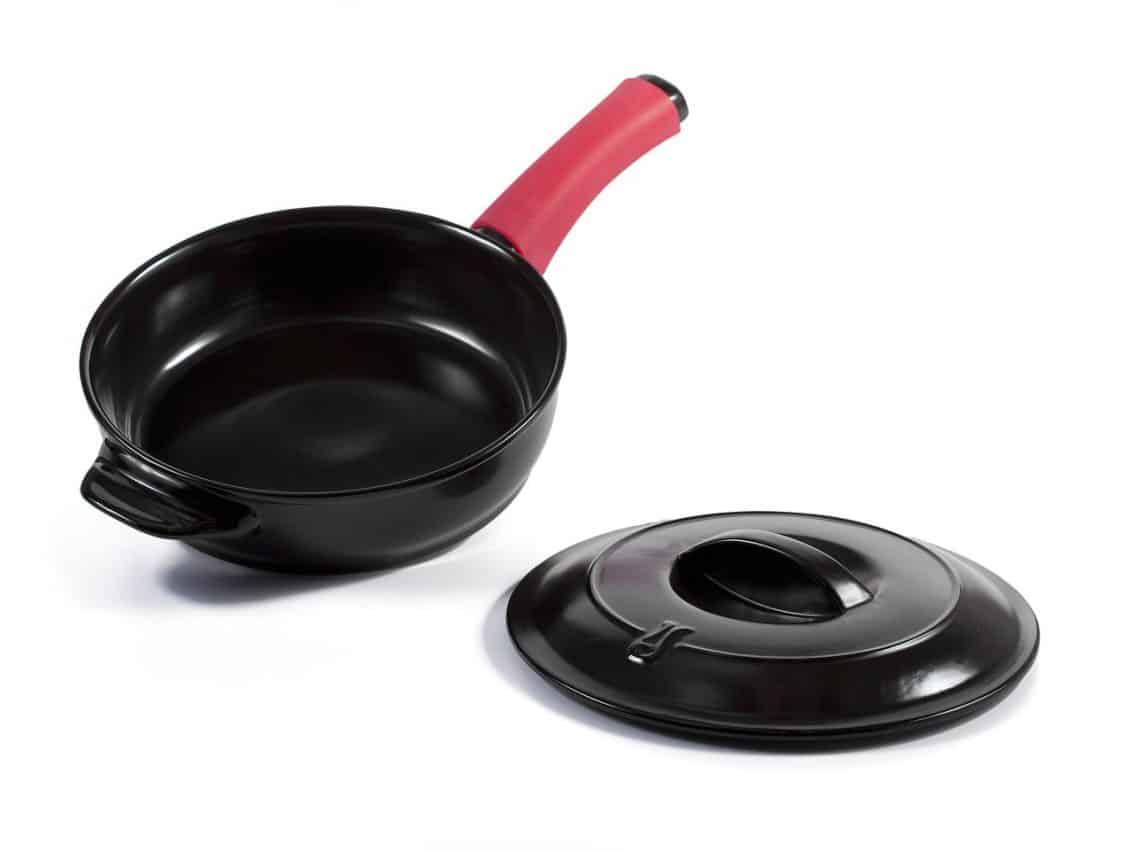

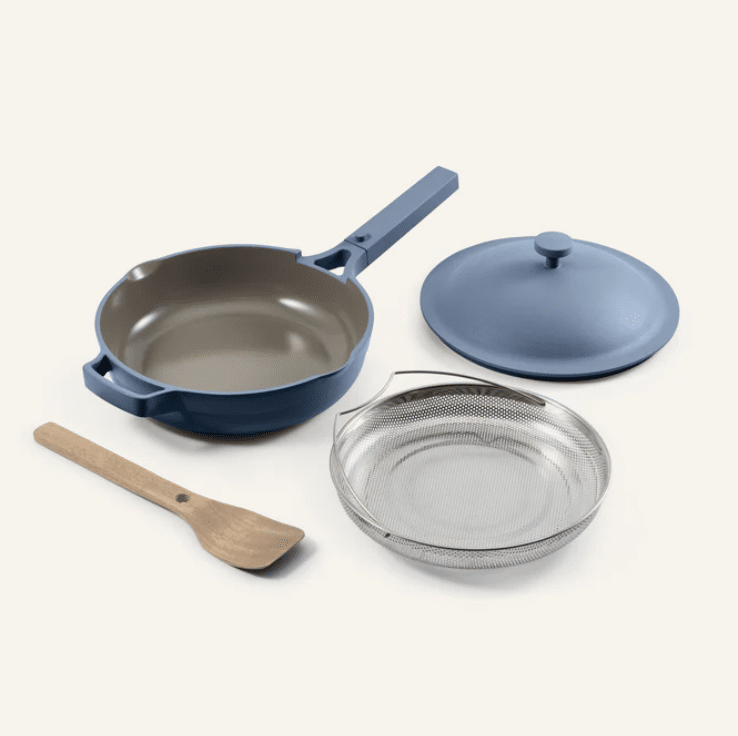

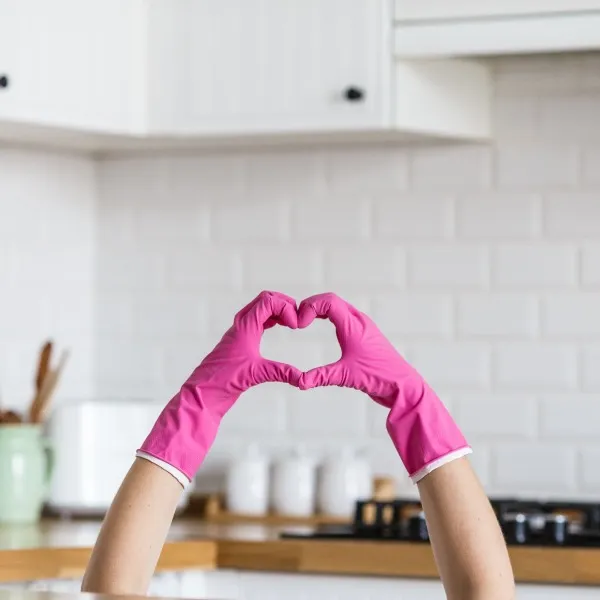

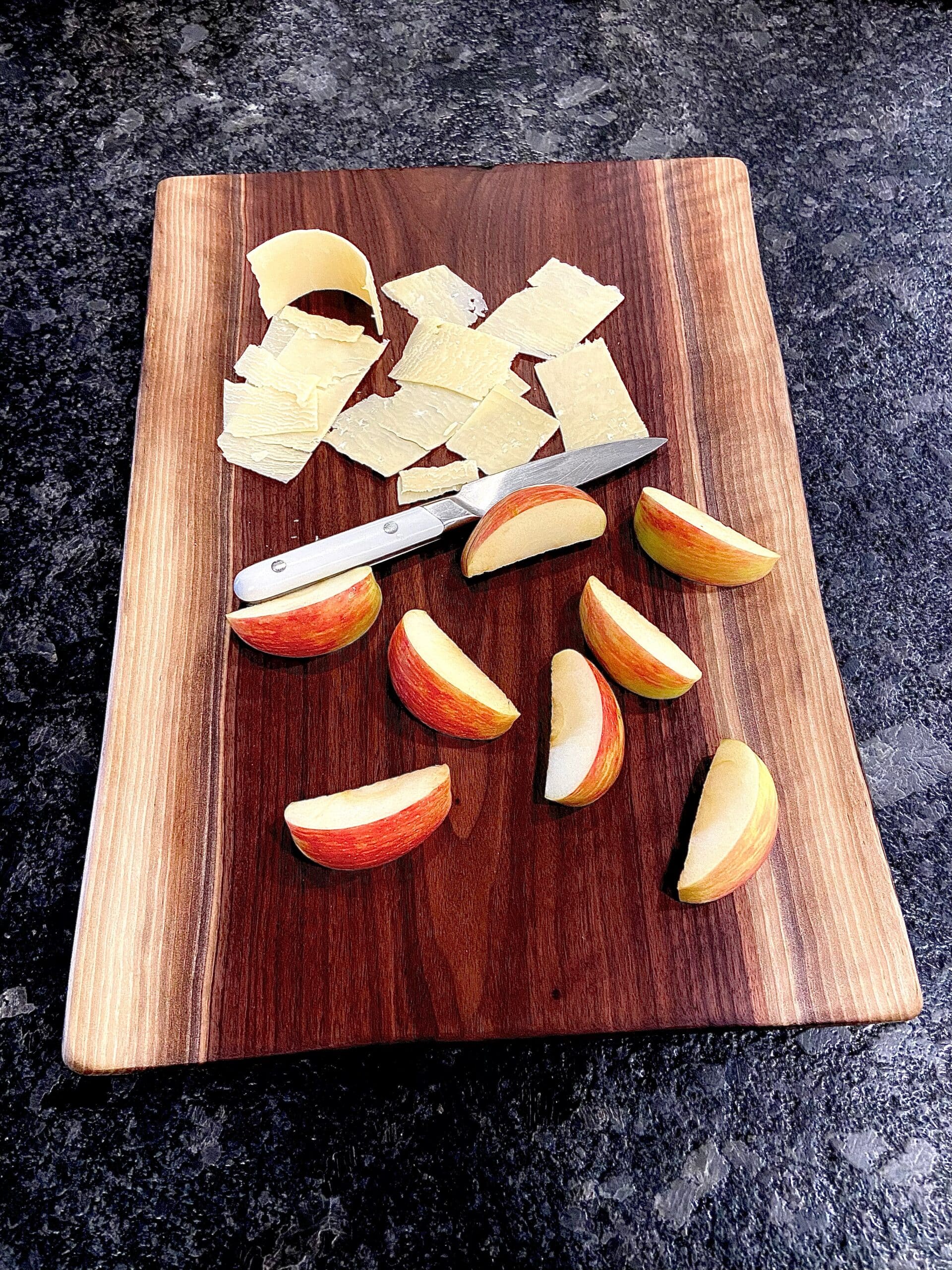
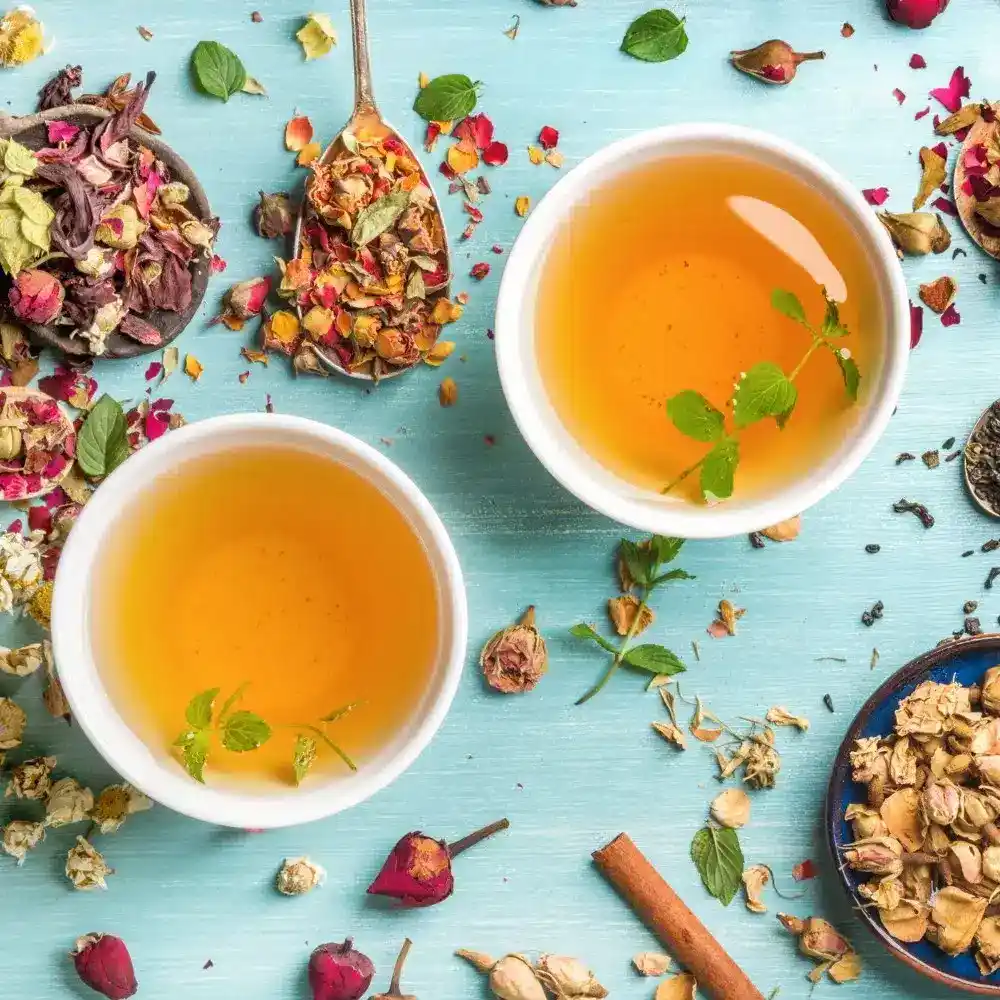
Leave a Reply
You must be logged in to post a comment.